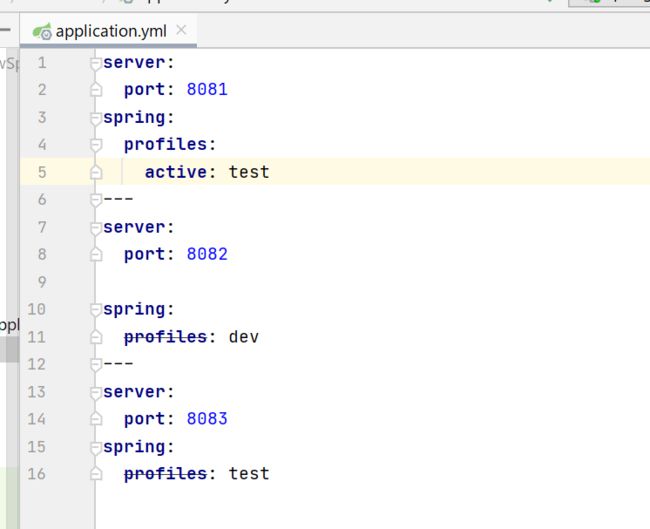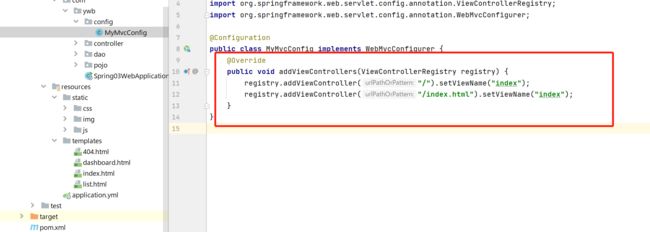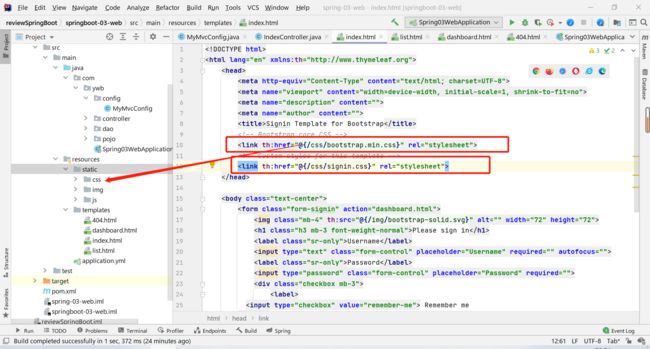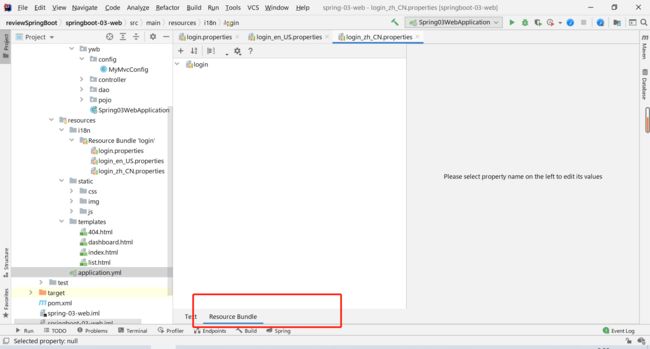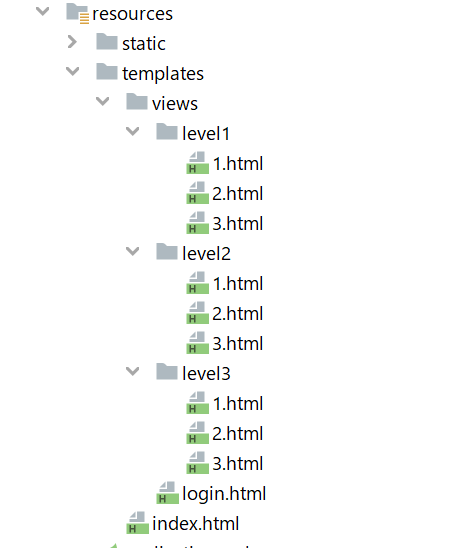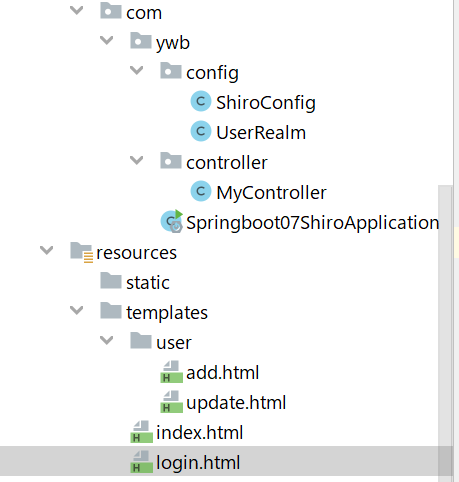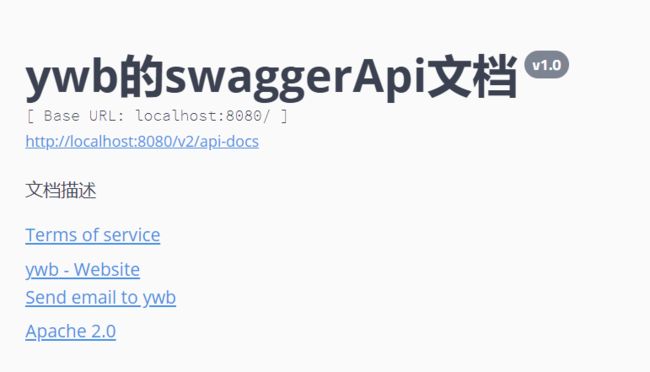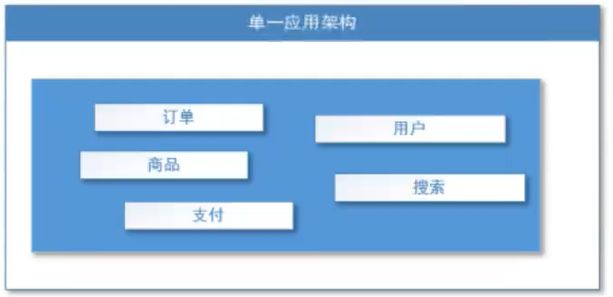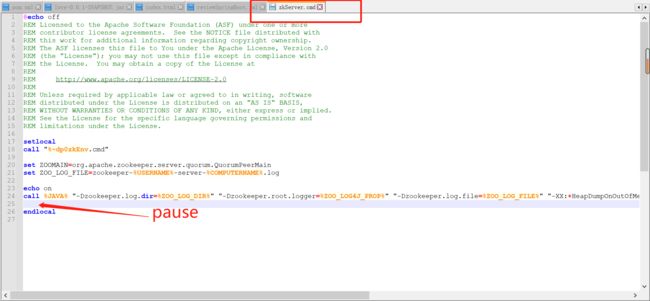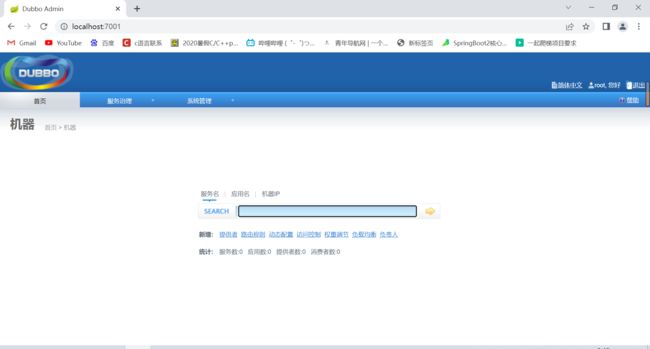SpringBoot
文章目录
- 一、入门
-
- 1.1、第一个springboot程序
- 1.2、自动装配原理
- 1.3、YAMl
-
- 给实体类赋值
- JSR303校验
- 多环境配置
- 二、springboot web开发
-
- 2.1、静态资源
- 2.2、首页定制
- 2.3、Thymeleaf模板引擎
- 2.4、MVC配置原理
- 2.5、项目实战
-
- 准备工作
- 国际化
- 登录验证
- 拦截器
- 头部栏和侧边栏抽象
- 重定向后Model的数据被清空
- 性别转换
- 日期格式转换
- 添加员工
- 修改员工
- 修改员工
- 404处理
- 注销功能
- 2.6、前端页面
- 三、连接数据库
-
- 3.1、整合JDBC使用
- 3.2、Druid数据源
- 3.3、整合Mybatis框架
- 四、SrpingSecurity
-
- 4.1、授权和认证
- 4.2、注销及权限控制
- 4.3、记住我和首页定制
- 五、Shiro
-
- 5.1、简介
- 5.2、登录拦截
- 5.3、用户认证
- 5.4、连接数据库
- 5.5、请求授权实现
- 5.6、Shiro整合Thymeleaf
- 六、Swagger
-
- 6.1、简介
- 6.2、SpringBoot集成Swagger
- 6.3、配置swagger
- 6.4、Swagger配置扫描接口
- 6.5、配置是否启动Swagger
- 6.6、配置Swagger只在生产环境中使用
- 6.7、配置API分组
- 6.8、实体类配置
- 七、任务
-
- 7.1、异步任务
- 7.2、邮件发送
- 7.3、定时任务
- 八、SpringBoot整合Redis
-
- 8.1、整合测试
- 8.2、自定义RedisTemplate模板
- 8.3、自定义Redis工具类
- 九、分布式 Dubbo+Zookeeper+SpringBoot
-
- 9.1、什么是分布式系统?
- 9.2、RPC
- 9.3、Dubbo
- 9.4、Zookeeper
- 9.5、安装dubbo
- 9.6、实战
一、入门
1.1、第一个springboot程序
pom.xml
<project xmlns="http://maven.apache.org/POM/4.0.0" xmlns:xsi="http://www.w3.org/2001/XMLSchema-instance"
xsi:schemaLocation="http://maven.apache.org/POM/4.0.0 https://maven.apache.org/xsd/maven-4.0.0.xsd">
<modelVersion>4.0.0modelVersion>
<parent>
<groupId>org.springframework.bootgroupId>
<artifactId>spring-boot-starter-parentartifactId>
<version>2.6.4version>
<relativePath/>
parent>
<groupId>com.ywbgroupId>
<artifactId>springboot-01-helloworldartifactId>
<version>0.0.1-SNAPSHOTversion>
<name>springboot-01-helloworldname>
<description>Demo project for Spring Bootdescription>
<properties>
<java.version>1.8java.version>
properties>
<dependencies>
<dependency>
<groupId>org.springframework.bootgroupId>
<artifactId>spring-boot-starter-webartifactId>
dependency>
<dependency>
<groupId>org.springframework.bootgroupId>
<artifactId>spring-boot-starter-testartifactId>
<scope>testscope>
dependency>
dependencies>
<build>
<plugins>
<plugin>
<groupId>org.springframework.bootgroupId>
<artifactId>spring-boot-maven-pluginartifactId>
plugin>
plugins>
build>
project>
controller
@RestController
@RequestMapping("/hello")
public class HelloController {
@GetMapping("/hello")
public String hello(){
return "hello world";
}
}
1.2、自动装配原理
自动配置
pom.xml
- spring-boot-dependencies:核心依赖在父工程中
- 我们在写或者引入一些springboot依赖的时候,不需要指定版本,就是因为有这些版本仓库
启动器:
<dependency>
<groupId>org.springframework.bootgroupId>
<artifactId>spring-boot-starter-webartifactId>
dependency>
说白了就是springboot的启动场景
比如spring-boot-starter-web,就会帮我们自动导入web环境所有的依赖
springboot会将所有的功能场景,都变成一个个的启动器
我们要使用什么功能,就只需要找到对应的启动器就可以了starter
主程序
//@SpringBootApplication:标注这个类是一个Springboot的应用
@SpringBootApplication
public class Springboot01HelloworldApplication {
public static void main(String[] args) {
SpringApplication.run(Springboot01HelloworldApplication.class, args);
}
}
-
注解
-
@SpringBootConfiguration:springboot的配置 @Configuration:spring配置类 @Component:说明这也是一个spring的组件 @EnableAutoConfiguration:自动配置 @AutoConfigurationPackage:自动配置包 @Import(AutoConfigurationPackages.Registrar.class):自动配置 包注册 @Import(AutoConfigurationImportSelector.class):自动导入选择
-
结论:springboot所有自动配置都是在启动的时候扫描并加载:spring.factories所有的自动配置类都在这里面,但是不一定生效,要判断条件是否成立,只要导入了对应的start,就有对应的启动器了,有了启动器,我们自动装配就会生效,然后就配置成功!
1、springboot在启动的时候,从类路径下/META_INF/spring.factories获取指定的值
2、将这些自动配置的类导入容器,自动配置类就会生效,帮我们进行自动配置
3、以前我们需要自动配置的东西,现在springboot帮我们做了
4、整合javaEE,解决方案和自动配置的东西都在spring-boot-autoconfigure-2.6.4.jar下
5、它会把所有需要导入的组件,以类名的方式返回,这些组件就会被添加到容器
6、容器中也会存在非常多的xxxAutoConfiguration的文件,就是这些类给容器中导入了这个场景需要的所有组件,并自动配置@Configuration
7、有了自动配置类,免去了我们手动编写配置文件的工作
全面接管SpringMVC的配置
1、springboot启动会加载大量的自动配置类
2、我们看我们需要的功能有没有在springboot默认写好的自动配置类当中
3、我们再来看这个自动配置类中到底配置了哪些组件;(只要我们要用的组件存在其中,我们就不需要再手动配置了)
4、给容器中自动配置类添加组件的时候,会从properties类中获取某些属性。我们只需要在配置文件中指定这些属性的值即可
xxxAutoConfiguration:自动配置类,给容器中添加组件
xxxProperties:封装配置文件中相关属性
1.3、YAMl
# 对象
student:
name: xiaoming
age: 3
# 行内写法
sutdent: {name: xiaohong,age: 3}
# 数组
pets:
- cat
- dog
- pig
pets1: [cat,dog,pig]
给实体类赋值
@ConfigurationProperties(prefix = "xxxx")
实体类:
@Component
@NoArgsConstructor
@AllArgsConstructor
@Data
@ToString
public class Dog {
private String name;
private Integer age;
}
@Component
@NoArgsConstructor
@AllArgsConstructor
@Data
@ToString
@ConfigurationProperties(prefix = "person")
public class Person {
private String name;
private Integer age;
private boolean happy;
private Date birthday;
private Map<String,Object> maps;
private List<Object> lists;
private Dog dog;
}
application.yml:
person:
name: xiaoming
age: 18
#age: ${random.int}
#age: ${random.uuid}
happy: false
birthday: 2022/03/22
maps: {k1: v1,k2: v2}
lists:
- code
- music
- basketball
dog:
name: wangcai
age: 3
JSR303校验
导入依赖
<dependency>
<groupId>javax.validationgroupId>
<artifactId>validation-apiartifactId>
dependency>
<dependency>
<groupId>org.hibernategroupId>
<artifactId>hibernate-validatorartifactId>
<version>5.2.0.Finalversion>
dependency>
@Null 限制只能为null
@NotNull 限制必须不为null
@AssertFalse 限制必须为false
@AssertTrue 限制必须为true
@DecimalMax(value) 限制必须为一个不大于指定值的数字
@DecimalMin(value) 限制必须为一个不小于指定值的数字
@Digits(integer,fraction) 限制必须为一个小数,且整数部分的位数不能超过integer,小数部分的位数不能超过fraction
@Future 限制必须是一个将来的日期
@Max(value) 限制必须为一个不大于指定值的数字
@Min(value) 限制必须为一个不小于指定值的数字
@Past 限制必须是一个过去的日期
@Pattern(value) 限制必须符合指定的正则表达式
@Size(max,min) 限制字符长度必须在min到max之间
@Past 验证注解的元素值(日期类型)比当前时间早
@NotEmpty 验证注解的元素值不为null且不为空(字符串长度不为0、集合大小不为0)
@NotBlank 验证注解的元素值不为空(不为null、去除首位空格后长度为0),不同于@NotEmpty,@NotBlank只应用于字符串且在比较时会去除字符串的空格
@Email 验证注解的元素值是Email,也可以通过正则表达式和flag指定自定义的email格式
@Validated
public class Person {
@Email(message = "报错提示信息")
private String name;
private Integer age;
private boolean happy;
private Date birthday;
private Map<String,Object> maps;
private List<Object> lists;
private Dog dog;
}
多环境配置
方式一:
方式二:
二、springboot web开发
自动装配
springboot到底帮我们配置了什么,能不能进行修改,能修改哪些东西,能不能扩展
- xxxAutoConfiguration…向容器中自动配置组件
- xxxProperties:自动配置类,装配配置文件中自定义的一些内容
要解决的问题:
- 导入静态资源
- 首页
- jsp,模板引擎Thymeleaf
- 装配扩展springmvc
- CRUD
- 拦截器
- 国际化
2.1、静态资源
三个目录都可以放静态资源
优先级:resources > static > public
2.2、首页定制
将index.html放在static目录下
放在templates目录下的所有页面,只能通过controller来跳转,需要thymeleaf
2.3、Thymeleaf模板引擎
导入依赖
<dependency>
<groupId>org.thymeleafgroupId>
<artifactId>thymeleaf-spring5artifactId>
dependency>
<dependency>
<groupId>org.thymeleaf.extrasgroupId>
<artifactId>thymeleaf-extras-java8timeartifactId>
dependency>
结论:想要使用thymeleaf,只需要导入对应的依赖就可以了!我们将html放在我们的templates目录下
DOCTYPE html>
<html lang="en" xmlns:th="http://www.thymeleaf.org">
<head>
<meta charset="UTF-8">
<title>Titletitle>
head>
<body>
<div th:text="${msg}">div>
<div th:utext="${msg}">div>
<hr>
<div th:each="user:${users}" th:text="${user}">div>
<hr>
<div th:each="user:${users}">[[ ${user} ]]div>
body>
html>
2.4、MVC配置原理
@Configuration
public class MyMvcConfig implements WebMvcConfigurer {
@Override
public void addViewControllers(ViewControllerRegistry registry) {
registry.addViewController("/yang").setViewName("test");
}
}
在springboot中,有非常多的xxxxConfiguration会帮助我们进行扩展配置,只要看见了这个东西,我们就要注意了
2.5、项目实战
准备工作
设置请求映射首页
html中的路径需要用th标签,路径用@{}来取,且静态资源放在static下
国际化
在resources目录下建目录i18n
新建login.properties,login_zh_CN.properties文件,会自动合并
在properties文件的下方可以选择可视化配置
[外链图片转存失败,源站可能有防盗链机制,建议将图片保存下来直接上传(img-7fGVtcY2-1648660959342)(C:/Users/杨维彬的电脑/AppData/Roaming/Typora/typora-user-images/image-20220324222227112.png)]
配置类:
/**
* @author ywb
* 国际化地区解析器
*/
public class MyLocaleResolver implements LocaleResolver {
@Override
public Locale resolveLocale(HttpServletRequest request) {
//获取请求中的语言参数连接
String lang = request.getParameter("lang");
Locale locale = Locale.getDefault();
if(!StringUtils.isEmpty(lang)){
String[] split = lang.split("_");
//国家,地区
locale = new Locale(split[0], split[1]);
}
return locale;
}
@Override
public void setLocale(HttpServletRequest request, HttpServletResponse response, Locale locale) {
}
}
在配置中加入组件:
@Configuration
public class MyMvcConfig implements WebMvcConfigurer {
@Override
public void addViewControllers(ViewControllerRegistry registry) {
registry.addViewController("/").setViewName("index");
registry.addViewController("/templates/index.html").setViewName("index");
}
//自定义的国际化组件生效
@Bean
public LocaleResolver localeResolver(){
return new MyLocaleResolver();
}
}
带有国际化的主页界面:
在thymeleaf中使用#{}引用
正常文本用th:text
按钮用th:value
DOCTYPE html>
<html lang="en" xmlns:th="http://www.thymeleaf.org">
<head>
<meta http-equiv="Content-Type" content="text/html; charset=UTF-8">
<meta name="viewport" content="width=device-width, initial-scale=1, shrink-to-fit=no">
<meta name="description" content="">
<meta name="author" content="">
<title>Signin Template for Bootstraptitle>
<link th:href="@{/css/bootstrap.min.css}" rel="stylesheet">
<link th:href="@{/css/signin.css}" rel="stylesheet">
head>
<body class="text-center">
<form class="form-signin" action="dashboard.html">
<img class="mb-4" th:src="@{/img/bootstrap-solid.svg}" alt="" width="72" height="72">
<h1 class="h3 mb-3 font-weight-normal" th:text="#{login.tip}">Please sign inh1>
<input type="text" class="form-control" th:placeholder="#{login.username}" required="" autofocus="">
<input type="password" class="form-control" th:placeholder="#{login.password}" required="">
<div class="checkbox mb-3">
<label>
<input type="checkbox" value="remember-me"> [[#{login.remember}]]
label>
div>
<button class="btn btn-lg btn-primary btn-block" type="submit" th:text="#{login.btn}">Sign inbutton>
<p class="mt-5 mb-3 text-muted">© 2017-2018p>
<a class="btn btn-sm" th:href="@{/index.html(lang='zh_CN')}">中文a>
<a class="btn btn-sm" th:href="@{/index.html(lang='en_US')}">Englisha>
form>
body>
html>
登录验证
Controller:
@Controller
public class HelloController {
@RequestMapping("/user/login")
public String login(@RequestParam("username") String username, @RequestParam("password") String password, Model model){
//具体的业务
if (username!=null && "123456".equals(password)){
//为了不显示真实的请求地址和暴露参数(用户名,密码)
//注意加一个斜杆"/"
return "redirect:/main.html";
}else {
model.addAttribute("msg","用户名或者密码错误");
return "index";
}
}
}
设置映射路径:
@Configuration
public class MyMvcConfig implements WebMvcConfigurer {
@Override
public void addViewControllers(ViewControllerRegistry registry) {
registry.addViewController("/").setViewName("index");
registry.addViewController("/index.html").setViewName("index");
registry.addViewController("/main.html").setViewName("dashboard");
}
}
index的form表单中增加用户名密码错误提示信息
<form class="form-signin" th:action="@{/user/login}">
<img class="mb-4" th:src="@{/img/bootstrap-solid.svg}" alt="" width="72" height="72">
<h1 class="h3 mb-3 font-weight-normal" th:text="#{login.tip}">Please sign inh1>
<p style="color: red" th:text="${msg}" th:if="${msg}!=null">p>
<input type="text" name="username" class="form-control" th:placeholder="#{login.username}" required="" autofocus="">
<input type="password" name="password" class="form-control" th:placeholder="#{login.password}" required="">
<div class="checkbox mb-3">
<label>
<input type="checkbox" value="remember-me"> [[#{login.remember}]]
label>
div>
<button class="btn btn-lg btn-primary btn-block" type="submit" th:text="#{login.btn}">Sign inbutton>
<p class="mt-5 mb-3 text-muted">© 2017-2018p>
<a class="btn btn-sm" th:href="@{/index.html(lang='zh_CN')}">中文a>
<a class="btn btn-sm" th:href="@{/index.html(lang='en_US')}">Englisha>
form>
拦截器
自定义拦截器类:
/**
* @author ywb
* 拦截器类
*/
public class LoginHandlerInterceptor implements HandlerInterceptor {
@Override
public boolean preHandle(HttpServletRequest request, HttpServletResponse response, Object handler) throws Exception {
//登录成功之后应该有用户的session
Object loginUser = request.getSession().getAttribute("loginUser");
if (loginUser==null){
//将在主页中显示
request.setAttribute("msg","没有权限,请先登录");
request.getRequestDispatcher("/index.html").forward(request,response);
//不登陆,不放行
return false;
}
return true;
}
}
在webConfig中配置拦截器需要拦截哪些请求
@Configuration
public class MyMvcConfig implements WebMvcConfigurer {
@Override
public void addViewControllers(ViewControllerRegistry registry) {
registry.addViewController("/").setViewName("index");
registry.addViewController("/index.html").setViewName("index");
registry.addViewController("/main.html").setViewName("dashboard");
}
@Override
public void addInterceptors(InterceptorRegistry registry) {
// /** 是拦截所有的文件夹及里面的子文件夹
registry.addInterceptor(new LoginHandlerInterceptor()).
addPathPatterns("/**").
excludePathPatterns("/","/index.html","/user/login","/css/*","/js/*","/img/**");
}
}
在html中取用户名,从session中取得
<nav class="navbar navbar-dark sticky-top bg-dark flex-md-nowrap p-0">
<a class="navbar-brand col-sm-3 col-md-2 mr-0" href="http://getbootstrap.com/docs/4.0/examples/dashboard/#">[[${session.loginUser}]]a>
<input class="form-control form-control-dark w-100" type="text" placeholder="Search" aria-label="Search">
<ul class="navbar-nav px-3">
<li class="nav-item text-nowrap">
<a class="nav-link" href="http://getbootstrap.com/docs/4.0/examples/dashboard/#">Sign outa>
li>
ul>
nav>
头部栏和侧边栏抽象
抽取:th:fragment="xxxx"
DOCTYPE html>
<html lang="en" xmlns:th="http://www.themeleaf.org">
<nav class="navbar navbar-dark sticky-top bg-dark flex-md-nowrap p-0" th:fragment="topbar">
<a class="navbar-brand col-sm-3 col-md-2 mr-0" href="http://getbootstrap.com/docs/4.0/examples/dashboard/#">[[${session.loginUser}]]a>
<input class="form-control form-control-dark w-100" type="text" placeholder="Search" aria-label="Search">
<ul class="navbar-nav px-3">
<li class="nav-item text-nowrap">
<a class="nav-link" href="http://getbootstrap.com/docs/4.0/examples/dashboard/#">Sign outa>
li>
ul>
nav>
<nav class="col-md-2 d-none d-md-block bg-light sidebar" th:fragment="sidebar">
<div class="sidebar-sticky">
<ul class="nav flex-column">
<li class="nav-item">
<a th:class="${active}=='main.html'?'nav-link active':'nav-link'" th:href="@{/index.html}">
<svg xmlns="http://www.w3.org/2000/svg" width="24" height="24" viewBox="0 0 24 24" fill="none" stroke="currentColor" stroke-width="2" stroke-linecap="round" stroke-linejoin="round" class="feather feather-home">
<path d="M3 9l9-7 9 7v11a2 2 0 0 1-2 2H5a2 2 0 0 1-2-2z">path>
<polyline points="9 22 9 12 15 12 15 22">polyline>
svg>
Dashboard <span class="sr-only">(current)span>
a>
li>
<li class="nav-item">
<a class="nav-link" href="http://getbootstrap.com/docs/4.0/examples/dashboard/#">
<svg xmlns="http://www.w3.org/2000/svg" width="24" height="24" viewBox="0 0 24 24" fill="none" stroke="currentColor" stroke-width="2" stroke-linecap="round" stroke-linejoin="round" class="feather feather-file">
<path d="M13 2H6a2 2 0 0 0-2 2v16a2 2 0 0 0 2 2h12a2 2 0 0 0 2-2V9z">path>
<polyline points="13 2 13 9 20 9">polyline>
svg>
Orders
a>
li>
<li class="nav-item">
<a class="nav-link" href="http://getbootstrap.com/docs/4.0/examples/dashboard/#">
<svg xmlns="http://www.w3.org/2000/svg" width="24" height="24" viewBox="0 0 24 24" fill="none" stroke="currentColor" stroke-width="2" stroke-linecap="round" stroke-linejoin="round" class="feather feather-shopping-cart">
<circle cx="9" cy="21" r="1">circle>
<circle cx="20" cy="21" r="1">circle>
<path d="M1 1h4l2.68 13.39a2 2 0 0 0 2 1.61h9.72a2 2 0 0 0 2-1.61L23 6H6">path>
svg>
Products
a>
li>
<li class="nav-item">
<a th:class="${active}=='list.html'?'nav-link active':'nav-link'" th:href="@{/emp/list}">
<svg xmlns="http://www.w3.org/2000/svg" width="24" height="24" viewBox="0 0 24 24" fill="none" stroke="currentColor" stroke-width="2" stroke-linecap="round" stroke-linejoin="round" class="feather feather-users">
<path d="M17 21v-2a4 4 0 0 0-4-4H5a4 4 0 0 0-4 4v2">path>
<circle cx="9" cy="7" r="4">circle>
<path d="M23 21v-2a4 4 0 0 0-3-3.87">path>
<path d="M16 3.13a4 4 0 0 1 0 7.75">path>
svg>
Customers
a>
li>
<li class="nav-item">
<a class="nav-link" href="http://getbootstrap.com/docs/4.0/examples/dashboard/#">
<svg xmlns="http://www.w3.org/2000/svg" width="24" height="24" viewBox="0 0 24 24" fill="none" stroke="currentColor" stroke-width="2" stroke-linecap="round" stroke-linejoin="round" class="feather feather-bar-chart-2">
<line x1="18" y1="20" x2="18" y2="10">line>
<line x1="12" y1="20" x2="12" y2="4">line>
<line x1="6" y1="20" x2="6" y2="14">line>
svg>
Reports
a>
li>
<li class="nav-item">
<a class="nav-link" href="http://getbootstrap.com/docs/4.0/examples/dashboard/#">
<svg xmlns="http://www.w3.org/2000/svg" width="24" height="24" viewBox="0 0 24 24" fill="none" stroke="currentColor" stroke-width="2" stroke-linecap="round" stroke-linejoin="round" class="feather feather-layers">
<polygon points="12 2 2 7 12 12 22 7 12 2">polygon>
<polyline points="2 17 12 22 22 17">polyline>
<polyline points="2 12 12 17 22 12">polyline>
svg>
Integrations
a>
li>
ul>
<h6 class="sidebar-heading d-flex justify-content-between align-items-center px-3 mt-4 mb-1 text-muted">
<span>Saved reportsspan>
<a class="d-flex align-items-center text-muted" href="http://getbootstrap.com/docs/4.0/examples/dashboard/#">
<svg xmlns="http://www.w3.org/2000/svg" width="24" height="24" viewBox="0 0 24 24" fill="none" stroke="currentColor" stroke-width="2" stroke-linecap="round" stroke-linejoin="round" class="feather feather-plus-circle"><circle cx="12" cy="12" r="10">circle><line x1="12" y1="8" x2="12" y2="16">line><line x1="8" y1="12" x2="16" y2="12">line>svg>
a>
h6>
<ul class="nav flex-column mb-2">
<li class="nav-item">
<a class="nav-link" href="http://getbootstrap.com/docs/4.0/examples/dashboard/#">
<svg xmlns="http://www.w3.org/2000/svg" width="24" height="24" viewBox="0 0 24 24" fill="none" stroke="currentColor" stroke-width="2" stroke-linecap="round" stroke-linejoin="round" class="feather feather-file-text">
<path d="M14 2H6a2 2 0 0 0-2 2v16a2 2 0 0 0 2 2h12a2 2 0 0 0 2-2V8z">path>
<polyline points="14 2 14 8 20 8">polyline>
<line x1="16" y1="13" x2="8" y2="13">line>
<line x1="16" y1="17" x2="8" y2="17">line>
<polyline points="10 9 9 9 8 9">polyline>
svg>
Current month
a>
li>
<li class="nav-item">
<a class="nav-link" href="http://getbootstrap.com/docs/4.0/examples/dashboard/#">
<svg xmlns="http://www.w3.org/2000/svg" width="24" height="24" viewBox="0 0 24 24" fill="none" stroke="currentColor" stroke-width="2" stroke-linecap="round" stroke-linejoin="round" class="feather feather-file-text">
<path d="M14 2H6a2 2 0 0 0-2 2v16a2 2 0 0 0 2 2h12a2 2 0 0 0 2-2V8z">path>
<polyline points="14 2 14 8 20 8">polyline>
<line x1="16" y1="13" x2="8" y2="13">line>
<line x1="16" y1="17" x2="8" y2="17">line>
<polyline points="10 9 9 9 8 9">polyline>
svg>
Last quarter
a>
li>
<li class="nav-item">
<a class="nav-link" href="http://getbootstrap.com/docs/4.0/examples/dashboard/#">
<svg xmlns="http://www.w3.org/2000/svg" width="24" height="24" viewBox="0 0 24 24" fill="none" stroke="currentColor" stroke-width="2" stroke-linecap="round" stroke-linejoin="round" class="feather feather-file-text">
<path d="M14 2H6a2 2 0 0 0-2 2v16a2 2 0 0 0 2 2h12a2 2 0 0 0 2-2V8z">path>
<polyline points="14 2 14 8 20 8">polyline>
<line x1="16" y1="13" x2="8" y2="13">line>
<line x1="16" y1="17" x2="8" y2="17">line>
<polyline points="10 9 9 9 8 9">polyline>
svg>
Social engagement
a>
li>
<li class="nav-item">
<a class="nav-link" href="http://getbootstrap.com/docs/4.0/examples/dashboard/#">
<svg xmlns="http://www.w3.org/2000/svg" width="24" height="24" viewBox="0 0 24 24" fill="none" stroke="currentColor" stroke-width="2" stroke-linecap="round" stroke-linejoin="round" class="feather feather-file-text">
<path d="M14 2H6a2 2 0 0 0-2 2v16a2 2 0 0 0 2 2h12a2 2 0 0 0 2-2V8z">path>
<polyline points="14 2 14 8 20 8">polyline>
<line x1="16" y1="13" x2="8" y2="13">line>
<line x1="16" y1="17" x2="8" y2="17">line>
<polyline points="10 9 9 9 8 9">polyline>
svg>
Year-end sale
a>
li>
ul>
div>
nav>
html>
使用:
<div th:insert="~{commons/commons::topbar}">div>
<div th:insert="~{commons/commons::sidebar(active='list.html')}">div>
thymeleaf传参:(xxx='xxx')
三元运算符判断条件显示高亮
<div th:insert="~{commons/commons::sidebar(active='list.html')}">div>
<a th:class="${active}=='main.html'?'nav-link active':'nav-link'" th:href="@{/index.html}">
<svg xmlns="http://www.w3.org/2000/svg" width="24" height="24" viewBox="0 0 24 24" fill="none" stroke="currentColor" stroke-width="2" stroke-linecap="round" stroke-linejoin="round" class="feather feather-home">
<path d="M3 9l9-7 9 7v11a2 2 0 0 1-2 2H5a2 2 0 0 1-2-2z">path>
<polyline points="9 22 9 12 15 12 15 22">polyline>
svg>
Dashboard <span class="sr-only">(current)span>
a>
<a th:class="${active}=='list.html'?'nav-link active':'nav-link'" th:href="@{/emp/list}">
<svg xmlns="http://www.w3.org/2000/svg" width="24" height="24" viewBox="0 0 24 24" fill="none" stroke="currentColor" stroke-width="2" stroke-linecap="round" stroke-linejoin="round" class="feather feather-users">
<path d="M17 21v-2a4 4 0 0 0-4-4H5a4 4 0 0 0-4 4v2">path>
<circle cx="9" cy="7" r="4">circle>
<path d="M23 21v-2a4 4 0 0 0-3-3.87">path>
<path d="M16 3.13a4 4 0 0 1 0 7.75">path>
svg>
Customers
a>
可将公共部分抽出
重定向后Model的数据被清空
@Controller
public class EmployeeController {
@Autowired
EmployeeDao employeeDao;
@RequestMapping("/emp/list")
public String list(Model model){
Collection<Employee> employees = employeeDao.getEmployees();
model.addAttribute("employees",employees);
return "redirect:/list.html";
//return "emp/list";
}
}
/*
使用redirect重定向之后,model的数据会被清空
*/
把Model改为RedirectAttributesModelMap,同时把addAttribute改成addFlashAttribute
@Controller
public class EmployeeController {
@Autowired
EmployeeDao employeeDao;
@RequestMapping("/emp/list")
public String list(RedirectAttributesModelMap model){
Collection<Employee> employees = employeeDao.getEmployees();
model.addFlashAttribute("employees",employees);
return "redirect:/list.html";
//return "emp/list";
}
}
若直接使用请求转发,则可以直接使用Model
但改成RedirectAttributesModelMap后,在html页面的代码依然会报红
<table class="table table-striped table-sm">
<thead>
<tr>
<th>idth>
<th>nameth>
<th>emailth>
<th>genderth>
<th>departmentth>
<th>birthth>
tr>
thead>
<tbody>
<tr th:each="emp:${employees}">
<td th:text="${emp.getId()}">td>
<td th:text="${emp.getName()}">td>
<td th:text="${emp.getEmail()}">td>
<td th:text="${emp.getGender()}">td>
<td th:text="${emp.getDepartment().getDepartmentName()}">td>
<td th:text="${emp.getBirth()}">td>
tr>
tbody>
table>
性别转换
<td th:text="${emp.getGender()==0 ? '女' : '男'}">td>
日期格式转换
<td th:text="${#dates.format(emp.getBirth(),'yyyy-MM-dd HH:mm:ss')}">td>
添加员工
html页面:
DOCTYPE html>
<html lang="en" xmlns:th="http://www.thymeleaf.org">
<head>
<meta http-equiv="Content-Type" content="text/html; charset=UTF-8">
<meta name="viewport" content="width=device-width, initial-scale=1, shrink-to-fit=no">
<meta name="description" content="">
<meta name="author" content="">
<title>Dashboard Template for Bootstraptitle>
<link th:href="@{/css/bootstrap.min.css}" rel="stylesheet">
<link th:href="@{/css/dashboard.css}" rel="stylesheet">
<style type="text/css">
/* Chart.js */
@-webkit-keyframes chartjs-render-animation {
from {
opacity: 0.99
}
to {
opacity: 1
}
}
@keyframes chartjs-render-animation {
from {
opacity: 0.99
}
to {
opacity: 1
}
}
.chartjs-render-monitor {
-webkit-animation: chartjs-render-animation 0.001s;
animation: chartjs-render-animation 0.001s;
}
style>
head>
<body>
<div th:insert="~{commons/commons::topbar}">div>
<div class="container-fluid">
<div class="row">
<div th:insert="~{commons/commons::sidebar(active='list.html')}">div>
<main role="main" class="col-md-9 ml-sm-auto col-lg-10 pt-3 px-4">
<form th:action="@{/emp}" method="post">
<div class="form-group">
<label>LastNamelabel>
<input type="text" name="name" class="form-control" placeholder="lastname:zsr">
div>
<div class="form-group">
<label>Emaillabel>
<input type="email" name="email" class="form-control" placeholder="email:[email protected]">
div>
<div class="form-group">
<label>Genderlabel><br/>
<div class="form-check form-check-inline">
<input class="form-check-input" type="radio" name="gender" value="1">
<label class="form-check-label">男label>
div>
<div class="form-check form-check-inline">
<input class="form-check-input" type="radio" name="gender" value="0">
<label class="form-check-label">女label>
div>
div>
<div class="form-group">
<label>departmentlabel>
<select class="form-control" name="department.id">
<option th:each="department:${departments}" th:text="${department.getDepartmentName()}"
th:value="${department.getId()}">option>
select>
div>
<div class="form-group">
<label>Birthlabel>
<input type="text" name="birth" class="form-control" placeholder="birth:yyyy-MM-dd">
div>
<button type="submit" class="btn btn-primary">添加button>
form>
main>
div>
div>
<script type="text/javascript" th:src="@{/js/jquery-3.2.1.slim.min.js}">script>
<script type="text/javascript" th:src="@{/js/popper.min.js}">script>
<script type="text/javascript" th:src="@{/js/bootstrap.min.js}">script>
<script type="text/javascript" th:src="@{/js/feather.min.js}">script>
<script>
feather.replace()
script>
<script type="text/javascript" th:src="@{/js/Chart.min.js}">script>
<script>
var ctx = document.getElementById("myChart");
var myChart = new Chart(ctx, {
type: 'line',
data: {
labels: ["Sunday", "Monday", "Tuesday", "Wednesday", "Thursday", "Friday", "Saturday"],
datasets: [{
data: [15339, 21345, 18483, 24003, 23489, 24092, 12034],
lineTension: 0,
backgroundColor: 'transparent',
borderColor: '#007bff',
borderWidth: 4,
pointBackgroundColor: '#007bff'
}]
},
options: {
scales: {
yAxes: [{
ticks: {
beginAtZero: false
}
}]
},
legend: {
display: false,
}
}
});
script>
body>
html>
注意:
department的显示以及选法,传参的时候传的是id,因此字段的name是department.id,
Controller:
此处使用Restful风格,同一个请求路径,用不同的请求方法
@Controller
public class EmployeeController {
@Autowired
EmployeeDao employeeDao;
@Autowired
DepartmentDao departmentDao;
@RequestMapping("/emp/list")
public String list(Model model){
Collection<Employee> employees = employeeDao.getEmployees();
model.addAttribute("employees",employees);
//return "redirect:/list.html";
return "emp/list";
}
@GetMapping("/emp")
public String toAddPage(Model model){
Collection<Department> departments = departmentDao.getDepartments();
model.addAttribute("departments",departments);
//直接使用return时,地址栏会直接变成请求路径
return "emp/add";
}
@PostMapping("/emp")
public String addEmployee(Employee employee){
employeeDao.saveEmployee(employee);
//使用redirect时,地址栏会变成路径,/emp/list
return "redirect:/emp/list";
}
}
日期格式配置:
spring:
messages:
basename: i18n.login
thymeleaf:
cache: false
mvc:
format:
date: yyyy-MM-dd
修改员工
html页面
DOCTYPE html>
<html lang="en" xmlns:th="http://www.thymeleaf.org">
<head>
<meta http-equiv="Content-Type" content="text/html; charset=UTF-8">
<meta name="viewport" content="width=device-width, initial-scale=1, shrink-to-fit=no">
<meta name="description" content="">
<meta name="author" content="">
<title>Dashboard Template for Bootstraptitle>
<link th:href="@{/css/bootstrap.min.css}" rel="stylesheet">
<link th:href="@{/css/dashboard.css}" rel="stylesheet">
<style type="text/css">
/* Chart.js */
@-webkit-keyframes chartjs-render-animation {
from {
opacity: 0.99
}
to {
opacity: 1
}
}
@keyframes chartjs-render-animation {
from {
opacity: 0.99
}
to {
opacity: 1
}
}
.chartjs-render-monitor {
-webkit-animation: chartjs-render-animation 0.001s;
animation: chartjs-render-animation 0.001s;
}
style>
head>
<body>
<div th:insert="~{commons/commons::topbar}">div>
<div class="container-fluid">
<div class="row">
<div th:insert="~{commons/commons::sidebar(active='list.html')}">div>
<main role="main" class="col-md-9 ml-sm-auto col-lg-10 pt-3 px-4">
<form th:action="@{/updateEmp}" method="post">
<input type="hidden" name="id" th:value="${employee.getId()}">
<div class="form-group">
<label>LastNamelabel>
<input th:value="${employee.getName()}" type="text" name="name" class="form-control" placeholder="lastname:zsr">
div>
<div class="form-group">
<label>Emaillabel>
<input th:value="${employee.getEmail()}" type="email" name="email" class="form-control" placeholder="email:[email protected]">
div>
<div class="form-group">
<label>Genderlabel><br/>
<div class="form-check form-check-inline">
<input class="form-check-input" type="radio" name="gender" value="1" th:checked="${employee.getGender()}==1">
<label class="form-check-label">男label>
div>
<div class="form-check form-check-inline">
<input class="form-check-input" type="radio" name="gender" value="0" th:checked="${employee.getGender()}==0">
<label class="form-check-label">女label>
div>
div>
<div class="form-group">
<label>departmentlabel>
<select class="form-control" name="department.id">
<option th:each="department:${departments}" th:text="${department.getDepartmentName()}"
th:value="${department.getId()}" th:selected="${department.getId()==employee.getDepartment().getId()}">option>
select>
div>
<div class="form-group">
<label>Birthlabel>
<input type="text" name="birth" class="form-control" placeholder="birth:yyyy-MM-dd" th:value="${#dates.format(employee.getBirth(),'yyyy-MM-dd HH:mm:ss')}">
div>
<button type="submit" class="btn btn-primary">修改button>
form>
main>
div>
div>
<script type="text/javascript" th:src="@{/js/jquery-3.2.1.slim.min.js}">script>
<script type="text/javascript" th:src="@{/js/popper.min.js}">script>
<script type="text/javascript" th:src="@{/js/bootstrap.min.js}">script>
<script type="text/javascript" th:src="@{/js/feather.min.js}">script>
<script>
feather.replace()
script>
<script type="text/javascript" th:src="@{/js/Chart.min.js}">script>
<script>
var ctx = document.getElementById("myChart");
var myChart = new Chart(ctx, {
type: 'line',
data: {
labels: ["Sunday", "Monday", "Tuesday", "Wednesday", "Thursday", "Friday", "Saturday"],
datasets: [{
data: [15339, 21345, 18483, 24003, 23489, 24092, 12034],
lineTension: 0,
backgroundColor: 'transparent',
borderColor: '#007bff',
borderWidth: 4,
pointBackgroundColor: '#007bff'
}]
},
options: {
scales: {
yAxes: [{
ticks: {
beginAtZero: false
}
}]
},
legend: {
display: false,
}
}
});
script>
body>
html>
注意:
需要带上id隐藏域
<input type="hidden" name="id" th:value="${employee.getId()}">显示修改前的值使用th:value标签
注意单选和下拉框的默认选择
th:checked和th:selected
传递需要修改的员工id
<td><a class="btn btn-sm btn-primary" th:href="@{/emp/{id}(id=${emp.getId()})}">编辑a>td>
Controller:
@GetMapping("/emp/{id}")
public String toUpdateEmp(@PathVariable("id") Integer id, Model model){
//查出原来的数据
Employee employeeById = employeeDao.getEmployeeById(id);
model.addAttribute("employee",employeeById);
Collection<Department> departments = departmentDao.getDepartments();
model.addAttribute("departments",departments);
return "emp/update";
}
@PostMapping("/updateEmp")
public String updateEmp(Employee employee){
employeeDao.saveEmployee(employee);
return "redirect:/emp/list";
}
修改员工
html页面:
<td><a class="btn btn-sm btn-danger" th:href="@{/deleteEmp/{id}(id=${emp.getId()})}">删除a>td>
Controller:
@GetMapping("/deleteEmp/{id}")
public String deleteEmp(@PathVariable("id") Integer id){
employeeDao.delete(id);
return "redirect:/emp/list";
}
404处理
在templates下建一个文件夹error,把404.html放在下面,就会自动找到该页面
注销功能
页面:
<nav class="navbar navbar-dark sticky-top bg-dark flex-md-nowrap p-0" th:fragment="topbar">
<a class="navbar-brand col-sm-3 col-md-2 mr-0" href="http://getbootstrap.com/docs/4.0/examples/dashboard/#">[[${session.loginUser}]]a>
<input class="form-control form-control-dark w-100" type="text" placeholder="Search" aria-label="Search">
<ul class="navbar-nav px-3">
<li class="nav-item text-nowrap">
<a class="nav-link" th:href="@{/user/logout}">Sign outa>
li>
ul>
nav>
Controller:
@GetMapping("/user/logout")
public String logout(HttpSession session){
session.invalidate();
return "redirect:/";
}
2.6、前端页面
- Bootstrap
- Layui
- semantic-ui
- x-admin
三、连接数据库
3.1、整合JDBC使用
在yaml文件中配置数据库信息
spring:
datasource:
username: root
password: 123456
url: jdbc:mysql://localhost:3306/mybatis?serverTimezone=UTC&useUnicode=true&characterEncoding=utf-8
driver-class-name: com.mysql.jdbc.Driver
服务时间、是否使用Unicode编码,characterEncoding编码
jdbc:mysql://localhost:3306/mybatis?serverTimezone=UTC&useUnicode=true&characterEncoding=utf-8
在配置数据库之后spring就会自动生成JdbcTemplate类
我们可以通过这个类的对象使用数据库的相关操作
@RestController
public class JdbcController {
@Autowired
JdbcTemplate jdbcTemplate;
@GetMapping("/userList")
public List<Map<String,Object>> userList(){
String sql = "select * from user";
List<Map<String, Object>> maps = jdbcTemplate.queryForList(sql);
return maps;
}
@GetMapping("/addUser")
public String addUser(){
String sql = "insert into `user`(`id`,`name`,`pwd`) values(7,'xiaoming','123456')";
jdbcTemplate.update(sql);
return "add-ok";
}
@GetMapping("/updateUser/{id}")
public String updateUser(@PathVariable("id") Integer id){
String sql = "update user set name = ?, pwd = ? where id = "+id;
Object[] objects = new Object[2];
objects[0] = "xiaohong";
objects[1] = "654321";
jdbcTemplate.update(sql,objects);
return "update-ok";
}
@GetMapping("/deleteUser/{id}")
public String deleteUser(@PathVariable("id") Integer id){
String sql = "delete from user where id = "+id;
jdbcTemplate.update(sql);
return "delete-ok";
}
}
3.2、Druid数据源
1、导入依赖
<dependency>
<groupId>com.alibabagroupId>
<artifactId>druidartifactId>
<version>1.2.8version>
dependency>
<dependency>
<groupId>log4jgroupId>
<artifactId>log4jartifactId>
<version>1.2.17version>
dependency>
2、配置数据源
spring:
datasource:
username: root
password: 123456
url: jdbc:mysql://localhost:3306/mybatis?serverTimezone=UTC&useUnicode=true&characterEncoding=utf-8
driver-class-name: com.mysql.jdbc.Driver
type: com.alibaba.druid.pool.DruidDataSource
#Spring Boot 默认是不注入这些属性值的,需要自己绑定
#druid 数据源专有配置
initialSize: 5
minIdle: 5
maxActive: 20
maxWait: 60000
timeBetweenEvictionRunsMillis: 60000
minEvictableIdleTimeMillis: 300000
validationQuery: SELECT 1 FROM DUAL
testWhileIdle: true
testOnBorrow: false
testOnReturn: false
poolPreparedStatements: true
#配置监控统计拦截的filters,stat:监控统计、log4j:日志记录、wall:防御sql注入
#如果允许时报错 java.lang.ClassNotFoundException: org.apache.log4j.Priority
#则导入 log4j 依赖即可,Maven 地址:https://mvnrepository.com/artifact/log4j/log4j
filters: stat,wall,log4j
maxPoolPreparedStatementPerConnectionSize: 20
useGlobalDataSourceStat: true
connectionProperties: druid.stat.mergeSql=true;druid.stat.slowSqlMillis=500
3、编写配置类
@Configuration
public class DruidConfig {
@ConfigurationProperties(prefix = "spring.datasource")
@Bean
public DataSource druidDataSource(){
return new DruidDataSource();
}
/**
* 后台监控:web.xml ServletRegistrationBean
* 因为springboot内置了servlet容器,所以没有web.xml,替代方法:ServletRegistrationBean
* @return
*/
@Bean
public ServletRegistrationBean statViewServlet(){
ServletRegistrationBean<StatViewServlet> bean = new ServletRegistrationBean<>(new StatViewServlet(),"/druid/*");
//后台需要有人登录,账号密码配置
HashMap<String, String> initParameters = new HashMap<>();
//设置账号和密码,两个key是固定的
initParameters.put("loginUser","admin");
initParameters.put("loginPassword","1234567");
//允许谁访问,如果value为空,就是允许所有人访问
initParameters.put("allow","");
//设置初始化参数
bean.setInitParameters(initParameters);
return bean;
}
/**
* 过滤器
* @return
*/
@Bean
public FilterRegistrationBean webStatFilter(){
FilterRegistrationBean<Filter> bean = new FilterRegistrationBean<>();
bean.setFilter(new WebStatFilter());
HashMap<String, String> initParameters = new HashMap<>();
//这些东西不进行统计
initParameters.put("exclusions","*.js,*.css,/druid/*");
//可以过滤哪些请求
bean.setInitParameters(initParameters);
return bean;
}
}
访问监控页面:localhost:8080/druid
3.3、整合Mybatis框架
1、导入依赖
<dependency>
<groupId>org.mybatis.spring.bootgroupId>
<artifactId>mybatis-spring-boot-starterartifactId>
<version>2.2.1version>
dependency>
2、配置数据源和整合mybatis
spring:
datasource:
username: root
password: 123456
url: jdbc:mysql://localhost:3306/mybatis?useUnicode=true&serverTimezone=UTC&characterEncoding=utf-8
driver-class-name: com.mysql.cj.jdbc.Driver
mybatis:
type-aliases-package: com.ywb.pojo
mapper-locations: classpath:mybatis/mapper/*.xml
3、编写mapper接口
/**
* @author ywb
* 注解表示了这是一个mybatis的mapper类
*/
@Mapper
@Repository
public interface UserMapper {
/**
* 查找所有用户
* @return
*/
List<User> queryUserList();
/**
* 通过id查找用户
* @param id 用户id
* @return
*/
User queryUserById(Integer id);
/**
* 添加用户
* @param user
* @return
*/
Integer addUser(User user);
/**
* 更新用户
* @param user
* @return
*/
Integer updateUser(User user);
/**
* 删除用户
* @param id
* @return
*/
Integer deleteUser(Integer id);
}
4、编写mapper.xml文件
DOCTYPE mapper
PUBLIC "-//mybatis.org//DTD Mapper 3.0//EN"
"http://mybatis.org/dtd/mybatis-3-mapper.dtd">
<mapper namespace="com.ywb.mapper.UserMapper">
<select id="queryUserList" resultType="com.ywb.pojo.User">
select * from user
select>
<select id="queryUserById" resultType="com.ywb.pojo.User" parameterType="Integer">
select * from user where id = #{id}
select>
<insert id="addUser" parameterType="com.ywb.pojo.User">
insert into `user`(id,`name`,pwd) values(#{id},#{name},#{pwd})
insert>
<update id="updateUser" parameterType="com.ywb.pojo.User">
update user set name=#{name},pwd=#{pwd} where id = #{id}
update>
<delete id="deleteUser" parameterType="Integer">
delete from user where id = #{id}
delete>
mapper>
5、编写Controller
@RestController
public class UserController {
@Autowired
private UserMapper userMapper;
@GetMapping("/queryUserList")
public List<User> queryUserList(){
List<User> users = userMapper.queryUserList();
for (User user : users) {
System.out.println(user);
}
return users;
}
@GetMapping("/queryUserById/{id}")
public User queryUserById(@PathVariable("id") Integer id){
return userMapper.queryUserById(id);
}
@GetMapping("/addUser")
public String addUser(){
userMapper.addUser(new User(7,"小明","123456"));
return "ok";
}
@GetMapping("/updateUser")
public String updateUser(){
userMapper.updateUser(new User(7,"小明","989787"));
return "ok";
}
@GetMapping("/deleteUser/{id}")
public String deleteUser(@PathVariable("id") Integer id){
userMapper.deleteUser(id);
return "ok";
}
}
四、SrpingSecurity
4.1、授权和认证
1、导入依赖
<dependency>
<groupId>org.springframework.bootgroupId>
<artifactId>spring-boot-starter-securityartifactId>
dependency>
2、编写跳转路由
@Controller
public class RouterController {
@GetMapping({"/","/index"})
public String index(){
return "index";
}
@GetMapping("/toLogin")
public String toLogin(){
return "views/login";
}
@GetMapping("/level1/{id}")
public String level1(@PathVariable("id") Integer id){
return "views/level1/"+id;
}
@GetMapping("/level2/{id}")
public String level2(@PathVariable("id") Integer id){
return "views/level2/"+id;
}
@GetMapping("/level3/{id}")
public String level3(@PathVariable("id") Integer id){
return "views/level3/"+id;
}
}
3、编写配置类
@EnableWebSecurity
public class SecurityConfig extends WebSecurityConfigurerAdapter {
/**
* 授权
* 链式编程
* @param http
* @throws Exception
*/
@Override
protected void configure(HttpSecurity http) throws Exception {
//首页所有人都可以访问,功能页只有对应权限才可以访问
http.authorizeRequests()
.antMatchers("/").permitAll()
.antMatchers("/level1/**").hasRole("vip1")
.antMatchers("/level2/**").hasRole("vip2")
.antMatchers("/level3/**").hasRole("vip3");
//没有权限默认到登录页
http.formLogin();
}
/**
* 内存中的认证,密码需要编码,在Security5.0+新增了很多的加密方法
* @param auth
* @throws Exception
*/
@Override
protected void configure(AuthenticationManagerBuilder auth) throws Exception {
auth.inMemoryAuthentication().passwordEncoder(new BCryptPasswordEncoder())
.withUser("vip3").password(new BCryptPasswordEncoder().encode("123456")).roles("vip1","vip2","vip3")
.and().withUser("vip1").password(new BCryptPasswordEncoder().encode("123456")).roles("vip1")
.and().withUser("vip2").password(new BCryptPasswordEncoder().encode("123456")).roles("vip1","vip2");
}
}
如果使用数据库查询,则按照下图
4.2、注销及权限控制
1、注销
@Override
protected void configure(HttpSecurity http) throws Exception {
//首页所有人都可以访问,功能页只有对应权限才可以访问
http.authorizeRequests()
.antMatchers("/").permitAll()
.antMatchers("/level1/**").hasRole("vip1")
.antMatchers("/level2/**").hasRole("vip2")
.antMatchers("/level3/**").hasRole("vip3");
//没有权限默认到登录页
http.formLogin();
//开启注销功能
//默认跳到登录页面
http.logout();
//指定跳到指定路径
http.logout().logoutSuccessUrl("/");
//关闭csrf功能,登出失败可能的原因
http.csrf().disable();
}
2、权限控制,根据用户的不同权限动态显示不同的内容
导入依赖
<dependency>
<groupId>org.thymeleaf.extrasgroupId>
<artifactId>thymeleaf-extras-springsecurity6artifactId>
<version>3.1.0.M1version>
dependency>
在html中导入命名空间
xmlns:sec="http://www.thymeleaf.org/extras/spring-security"
DOCTYPE html>
<html lang="en" xmlns:th="http://www.thymeleaf.org"
xmlns:sec="http://www.thymeleaf.org/extras/spring-security">
<head>
<meta charset="UTF-8">
<meta name="viewport" content="width=device-width, initial-scale=1, maximum-scale=1">
<title>首页title>
<link href="https://cdn.bootcss.com/semantic-ui/2.4.1/semantic.min.css" rel="stylesheet">
<link th:href="@{/qinjiang/css/qinstyle.css}" rel="stylesheet">
head>
<body>
<div class="ui container">
<div class="ui segment" id="index-header-nav" th:fragment="nav-menu">
<div class="ui secondary menu">
<a class="item" th:href="@{/index}">首页a>
<div class="right menu">
<div sec:authorize="!isAuthenticated()">
<a class="item" th:href="@{/toLogin}">
<i class="address card icon">i> 登录
a>
div>
<div sec:authorize="isAuthenticated()">
<a class="item">
用户名:<span sec:authentication="name">span>
角色:<span sec:authentication="principal.authorities">span>
a>
div>
<div sec:authorize="isAuthenticated()">
<a class="item" th:href="@{/logout}">
<i class="sign-out icon">i> 注销
a>
div>
div>
div>
div>
<div class="ui segment" style="text-align: center">
<h3>Spring Security Study by meh3>
div>
<div>
<br>
<div class="ui three column stackable grid">
<div class="column" sec:authorize="hasRole('vip1')">
<div class="ui raised segment">
<div class="ui">
<div class="content">
<h5 class="content">Level 1h5>
<hr>
<div><a th:href="@{/level1/1}"><i class="bullhorn icon">i> Level-1-1a>div>
<div><a th:href="@{/level1/2}"><i class="bullhorn icon">i> Level-1-2a>div>
<div><a th:href="@{/level1/3}"><i class="bullhorn icon">i> Level-1-3a>div>
div>
div>
div>
div>
<div class="column" sec:authorize="hasRole('vip2')">
<div class="ui raised segment">
<div class="ui">
<div class="content">
<h5 class="content">Level 2h5>
<hr>
<div><a th:href="@{/level2/1}"><i class="bullhorn icon">i> Level-2-1a>div>
<div><a th:href="@{/level2/2}"><i class="bullhorn icon">i> Level-2-2a>div>
<div><a th:href="@{/level2/3}"><i class="bullhorn icon">i> Level-2-3a>div>
div>
div>
div>
div>
<div class="column" sec:authorize="hasRole('vip3')">
<div class="ui raised segment">
<div class="ui">
<div class="content">
<h5 class="content">Level 3h5>
<hr>
<div><a th:href="@{/level3/1}"><i class="bullhorn icon">i> Level-3-1a>div>
<div><a th:href="@{/level3/2}"><i class="bullhorn icon">i> Level-3-2a>div>
<div><a th:href="@{/level3/3}"><i class="bullhorn icon">i> Level-3-3a>div>
div>
div>
div>
div>
div>
div>
div>
<script th:src="@{/qinjiang/js/jquery-3.1.1.min.js}">script>
<script th:src="@{/qinjiang/js/semantic.min.js}">script>
body>
html>
主要部分:
<div sec:authorize="!isAuthenticated()">
<a class="item" th:href="@{/toLogin}">
<i class="address card icon">i> 登录
a>
div>
<div sec:authorize="isAuthenticated()">
<a class="item">
用户名:<span sec:authentication="name">span>
角色:<span sec:authentication="principal.authorities">span>
a>
div>
<div sec:authorize="isAuthenticated()">
<a class="item" th:href="@{/logout}">
<i class="sign-out icon">i> 注销
a>
div>
<div class="column" sec:authorize="hasRole('vip1')">
div>
<div class="column" sec:authorize="hasRole('vip2')">
div>
但以上最多支持springboot2.0.9版本
4.3、记住我和首页定制
注意,自定义登录页面后,登录请求路径也要自定义
@Override
protected void configure(HttpSecurity http) throws Exception {
//首页所有人都可以访问,功能页只有对应权限才可以访问
http.authorizeRequests()
.antMatchers("/").permitAll()
.antMatchers("/level1/**").hasRole("vip1")
.antMatchers("/level2/**").hasRole("vip2")
.antMatchers("/level3/**").hasRole("vip3");
//没有权限默认到登录页,设置登录页面的地址和登录请求的路径
http.formLogin().loginPage("/toLogin").loginProcessingUrl("/usr/login");
//开启注销功能
//默认跳到登录页面
http.logout();
//指定跳到指定路径
http.logout().logoutSuccessUrl("/");
//关闭csrf功能,登出失败可能的原因
http.csrf().disable();
//开启记住我功能,设置了一个cookie,默认保存两周
http.rememberMe().rememberMeParameter("remember");
}
登录页面:
DOCTYPE html>
<html lang="en" xmlns:th="http://www.thymeleaf.org">
<head>
<meta charset="UTF-8">
<meta name="viewport" content="width=device-width, initial-scale=1, maximum-scale=1">
<title>登录title>
<link href="https://cdn.bootcss.com/semantic-ui/2.4.1/semantic.min.css" rel="stylesheet">
head>
<body>
<div class="ui container">
<div class="ui segment">
<div style="text-align: center">
<h1 class="header">登录h1>
div>
<div class="ui placeholder segment">
<div class="ui column very relaxed stackable grid">
<div class="column">
<div class="ui form">
<form th:action="@{/usr/login}" method="post">
<div class="field">
<label>Usernamelabel>
<div class="ui left icon input">
<input type="text" placeholder="Username" name="username">
<i class="user icon">i>
div>
div>
<div class="field">
<label>Passwordlabel>
<div class="ui left icon input">
<input type="password" name="password">
<i class="lock icon">i>
div>
div>
<div class="field">
<input type="checkbox" name="remember">记住我
div>
<input type="submit" class="ui blue submit button"/>
form>
div>
div>
div>
div>
<div style="text-align: center">
<div class="ui label">
i>注册
div>
<br><br>
<small>www.baidu.comsmall>
div>
<div class="ui segment" style="text-align: center">
<h3>Spring Security Study by meh3>
div>
div>
div>
<script th:src="@{/qinjiang/js/jquery-3.1.1.min.js}">script>
<script th:src="@{/qinjiang/js/semantic.min.js}">script>
body>
html>
注意:使用自定义页面登录时,username,password,remember的name值需要和security中的参数对应
五、Shiro
5.1、简介
1、导入依赖
<dependency>
<groupId>org.apache.shirogroupId>
<artifactId>shiro-springartifactId>
<version>1.6.0version>
dependency>
2、配置文件 *.ini
3、功能列举
Subject currentUser = SecurityUtils.getSubject();
Session session = currentUser.getSession();
currentUser.isAuthenticated()
currentUser.getPrincipal()
currentUser.hasRole("schwartz")
currentUser.isPermitted("lightsaber:wield")
currentUser.logout();
Shiro三大组件:
Subject 用户
SecurityManager 管理所有用户
Realm 连接数据
5.2、登录拦截
编写Realm类
public class UserRealm extends AuthorizingRealm {
/**
* 授权
* @param principalCollection
* @return
*/
@Override
protected AuthorizationInfo doGetAuthorizationInfo(PrincipalCollection principalCollection) {
return null;
}
/**
* 认证
* @param authenticationToken
* @return
* @throws AuthenticationException
*/
@Override
protected AuthenticationInfo doGetAuthenticationInfo(AuthenticationToken authenticationToken) throws AuthenticationException {
return null;
}
}
配置类
@Configuration
public class ShiroConfig {
/**
* ShiroFilterFactoryBean,需要设置defaultWebSecurityManager
* @param defaultWebSecurityManager
* @return
*/
@Bean
public ShiroFilterFactoryBean shiroFilterFactoryBean(@Qualifier("defaultWebSecurityManager") DefaultWebSecurityManager defaultWebSecurityManager){
ShiroFilterFactoryBean factoryBean = new ShiroFilterFactoryBean();
//设置安全管理器
factoryBean.setSecurityManager(defaultWebSecurityManager);
//添加shiro的内置过滤器
/*
anno:无需认证就可以访问
authc:必须认证了才能访问
user:必须拥有 记住我 功能才能访问
perms:拥有对某个资源的权限才能访问
role:拥有某个角色权限才能访问
filterMap.put("/user/add","authc");
filterMap.put("/user/update","authc");
*/
Map<String, String> filterMap = new LinkedHashMap<>();
filterMap.put("/user/*","authc");
factoryBean.setFilterChainDefinitionMap(filterMap);
//设置登录的请求路径
factoryBean.setLoginUrl("/toLogin");
return factoryBean;
}
/**
* DefaultWebSecurityManager,需要绑定Realm
* @return
*/
@Bean
public DefaultWebSecurityManager defaultWebSecurityManager(@Qualifier("userRealm") UserRealm userRealm){
DefaultWebSecurityManager securityManager = new DefaultWebSecurityManager();
//关联userRealm
securityManager.setRealm(userRealm);
return securityManager;
}
/**
* 创建Realm对象,需要自定义
* @return
*/
@Bean
public UserRealm userRealm(){
return new UserRealm();
}
}
Controller:
@Controller
public class MyController {
@GetMapping({"/","index","index.html"})
public String toIndex(Model model){
model.addAttribute("msg","hello shiro");
return "index";
}
@GetMapping("/user/add")
public String add(){
return "user/add";
}
@GetMapping("/user/update")
public String update(){
return "user/update";
}
@GetMapping("/toLogin")
public String toLogin(){
return "login";
}
}
5.3、用户认证
在UserRealm中添加认证
public class UserRealm extends AuthorizingRealm {
/**
* 授权
* @param principalCollection
* @return
*/
@Override
protected AuthorizationInfo doGetAuthorizationInfo(PrincipalCollection principalCollection) {
System.out.println("授权==>doGetAuthorizationInfo");
return null;
}
/**
* 认证
* @param authenticationToken
* @return
* @throws AuthenticationException
*/
@Override
protected AuthenticationInfo doGetAuthenticationInfo(AuthenticationToken authenticationToken) throws AuthenticationException {
System.out.println("认证==>doGetAuthenticationInfo");
//用户名,密码,数据库中取得
String username = "admin",password = "123456";
UsernamePasswordToken userToken = (UsernamePasswordToken)authenticationToken;
//比对用户名
if (!userToken.getUsername().equals(username)){
//抛出异常UnknownAccountException
return null;
}
//密码认证由shiro来做
return new SimpleAuthenticationInfo("",password,"");
}
}
Controller:
@PostMapping("/login")
public String login(String username, String password, Model model){
System.out.println("Debug==>"+username);
System.out.println("Debug==>"+password);
//获取当前的用户
Subject subject = SecurityUtils.getSubject();
//封装用户的登录数据
UsernamePasswordToken token = new UsernamePasswordToken(username, password);
//执行登录方法,如果没有异常就ok了
try {
subject.login(token);
return "index";
}catch (UnknownAccountException e){
model.addAttribute("msg","用户名不存在");
return "login";
}catch (IncorrectCredentialsException e){
model.addAttribute("msg","密码错误");
return "login";
}
}
login.html:
DOCTYPE html>
<html lang="en" xmlns:th="http://www.themeleaf.org">
<head>
<meta charset="UTF-8">
<title>Titletitle>
head>
<body>
<h2>登录h2>
<p th:text="${msg}" style="color: red">p>
<form th:action="@{/login}" method="post">
<p>用户名:<input type="text" name="username">p>
<p>密码:<input type="text" name="password">p>
<p><input type="submit">p>
form>
body>
html>
配置类:
@Configuration
public class ShiroConfig {
/**
* ShiroFilterFactoryBean,需要设置defaultWebSecurityManager
* @param defaultWebSecurityManager
* @return
*/
@Bean
public ShiroFilterFactoryBean shiroFilterFactoryBean(@Qualifier("defaultWebSecurityManager") DefaultWebSecurityManager defaultWebSecurityManager){
ShiroFilterFactoryBean factoryBean = new ShiroFilterFactoryBean();
//设置安全管理器
factoryBean.setSecurityManager(defaultWebSecurityManager);
//添加shiro的内置过滤器
/*
anno:无需认证就可以访问
authc:必须认证了才能访问
user:必须拥有 记住我 功能才能访问
perms:拥有对某个资源的权限才能访问
role:拥有某个角色权限才能访问
filterMap.put("/user/add","authc");
filterMap.put("/user/update","authc");
*/
Map<String, String> filterMap = new LinkedHashMap<>();
filterMap.put("/user/*","authc");
factoryBean.setFilterChainDefinitionMap(filterMap);
//设置登录的请求路径
factoryBean.setLoginUrl("/toLogin");
return factoryBean;
}
/**
* DefaultWebSecurityManager,需要绑定Realm
* @return
*/
@Bean
public DefaultWebSecurityManager defaultWebSecurityManager(@Qualifier("userRealm") UserRealm userRealm){
DefaultWebSecurityManager securityManager = new DefaultWebSecurityManager();
//关联userRealm
securityManager.setRealm(userRealm);
securityManager.setSessionManager(sessionManager());
return securityManager;
}
/**
* 会话管理
* @return
*/
@Bean
public DefaultWebSessionManager sessionManager() {
DefaultWebSessionManager sessionManager = new DefaultWebSessionManager();
// 去掉shiro登录时url里的JSESSIONID
sessionManager.setSessionIdUrlRewritingEnabled(false);
return sessionManager;
}
/**
* 创建Realm对象,需要自定义
* @return
*/
@Bean
public UserRealm userRealm(){
return new UserRealm();
}
}
5.4、连接数据库
@Repository
@Mapper
public interface UserMapper {
public User queryUserByName(String name);
}
public interface UserService {
public User queryUserByName(String name);
}
@Service
public class UserServiceImpl implements UserService {
@Autowired
private UserMapper userMapper;
@Override
public User queryUserByName(String name) {
return userMapper.queryUserByName(name);
}
}
DOCTYPE mapper
PUBLIC "-//mybatis.org//DTD Mapper 3.0//EN"
"http://mybatis.org/dtd/mybatis-3-mapper.dtd">
<mapper namespace="com.ywb.mapper.UserMapper">
<select id="queryUserByName" resultType="User" parameterType="String">
select * from user where name = #{name}
select>
mapper>
使用数据库中的数据认证登录,UserRealm中
/**
* 认证
* @param authenticationToken
* @return
* @throws AuthenticationException
*/
@Override
protected AuthenticationInfo doGetAuthenticationInfo(AuthenticationToken authenticationToken) throws AuthenticationException {
System.out.println("认证==>doGetAuthenticationInfo");
//用户名,密码,数据库中取得
UsernamePasswordToken userToken = (UsernamePasswordToken)authenticationToken;
User user = userService.queryUserByName(userToken.getUsername());
//比对用户名
if (user == null){
//抛出异常UnknownAccountException
return null;
}
//密码认证由shiro来做,加密,可以用MD5加密,MD5盐值加密
return new SimpleAuthenticationInfo("",user.getPwd(),"");
}
5.5、请求授权实现
1、在数据库中增加权限字段
2、在拦截器添加拦截路径和权限判断
/**
* ShiroFilterFactoryBean,需要设置defaultWebSecurityManager
* @param defaultWebSecurityManager
* @return
*/
@Bean
public ShiroFilterFactoryBean shiroFilterFactoryBean(@Qualifier("defaultWebSecurityManager") DefaultWebSecurityManager defaultWebSecurityManager){
ShiroFilterFactoryBean factoryBean = new ShiroFilterFactoryBean();
//设置安全管理器
factoryBean.setSecurityManager(defaultWebSecurityManager);
//添加shiro的内置过滤器
/*
anno:无需认证就可以访问
authc:必须认证了才能访问
user:必须拥有 记住我 功能才能访问
perms:拥有对某个资源的权限才能访问
role:拥有某个角色权限才能访问
filterMap.put("/user/add","authc");
filterMap.put("/user/update","authc");
*/
Map<String, String> filterMap = new LinkedHashMap<>();
//授权,正常情况下,未授权会跳转到一个授权页面
filterMap.put("/user/add","perms[user:add]");
filterMap.put("/user/update","perms[user:update]");
filterMap.put("/user/*","authc");
factoryBean.setFilterChainDefinitionMap(filterMap);
//设置登录的请求路径
factoryBean.setLoginUrl("/toLogin");
//设置未授权页面
factoryBean.setUnauthorizedUrl("/noauth");
return factoryBean;
}
3、设置未授权跳转的页面
@RequestMapping("/noauth")
@ResponseBody
public String unauthorized(){
return "未经授权无法访问此页面";
}
4、根据数据库字段给用户添加权限
public class UserRealm extends AuthorizingRealm {
@Autowired
private UserService userService;
/**
* 授权
* @param principalCollection
* @return
*/
@Override
protected AuthorizationInfo doGetAuthorizationInfo(PrincipalCollection principalCollection) {
System.out.println("授权==>doGetAuthorizationInfo");
SimpleAuthorizationInfo info = new SimpleAuthorizationInfo();
//拿到当前登录的对象
Subject subject = SecurityUtils.getSubject();
User currentUser = (User) subject.getPrincipal();
String perms = currentUser.getPerms();
if (perms==null){
return info;
}
String[] permsList = perms.split(",");
for (String perm : permsList) {
info.addStringPermission(perm);
}
return info;
}
/**
* 认证
* @param authenticationToken
* @return
* @throws AuthenticationException
*/
@Override
protected AuthenticationInfo doGetAuthenticationInfo(AuthenticationToken authenticationToken) throws AuthenticationException {
System.out.println("认证==>doGetAuthenticationInfo");
//用户名,密码,数据库中取得
UsernamePasswordToken userToken = (UsernamePasswordToken)authenticationToken;
User user = userService.queryUserByName(userToken.getUsername());
//比对用户名
if (user == null){
//抛出异常UnknownAccountException
return null;
}
//密码认证由shiro来做,加密,可以用MD5加密,MD5盐值加密
return new SimpleAuthenticationInfo(user,user.getPwd(),"");
}
}
重点:
在认证代码中将用户返回给principal
return new SimpleAuthenticationInfo(user,user.getPwd(),"");
授权代码
SimpleAuthorizationInfo info = new SimpleAuthorizationInfo();
//拿到当前登录的对象
Subject subject = SecurityUtils.getSubject();
User currentUser = (User) subject.getPrincipal();
String perms = currentUser.getPerms();
String[] permsList = perms.split(",");
for (String perm : permsList) {
info.addStringPermission(perm);
}
5.6、Shiro整合Thymeleaf
1、导入依赖
<dependency>
<groupId>com.github.theborakompanionigroupId>
<artifactId>thymeleaf-extras-shiroartifactId>
<version>2.0.0version>
dependency>
2、生成ShiroDialect类
//整合shiroDialect:用来整合shiro-thymeleaf
@Bean
public ShiroDialect shiroDialect(){
return new ShiroDialect();
}
3、导入命名空间
<html lang="en" xmlns:th="http://www.thymeleaf.org"
xmlns:shiro="http://www.pollix.at/thymeleaf/shiro">
4、使用shiro标签进行判断
DOCTYPE html>
<html lang="en" xmlns:th="http://www.thymeleaf.org"
xmlns:shiro="http://www.pollix.at/thymeleaf/shiro">
<head>
<meta charset="UTF-8">
<title>Titletitle>
head>
<body>
<h2>首页h2>
<h3 th:text="${msg}">h3>
<p>
<div shiro:notAuthenticated="">
<a th:href="@{/toLogin}">登录a>
div>
p>
<div shiro:hasPermission="user:add">
<a th:href="@{/user/add}">adda>
div>
<div shiro:hasPermission="user:update">
<a th:href="@{/user/update}">updatea>
div>
body>
html>
六、Swagger
6.1、简介
- RestFul Api 文档在线自动生成工具=> Api文档和Api定义同步更新
- 直接运行,可以在线测试api接口
- 支持多种语言
在项目使用Swagger需要springfox
- swagger2
- ui
6.2、SpringBoot集成Swagger
1、新建一个SpringBoot
2、导入依赖
<dependency>
<groupId>io.springfoxgroupId>
<artifactId>springfox-swagger2artifactId>
<version>2.9.2version>
dependency>
<dependency>
<groupId>io.springfoxgroupId>
<artifactId>springfox-swagger-uiartifactId>
<version>2.9.2version>
dependency>
3、编写一个Hello工程
4、配置Swagger
@Configuration
@EnableSwagger2
public class SwaggerConfig {
}
5、重点!在yml文件中配置接口文档
spring:
mvc:
pathmatch:
matching-strategy: ant_path_matcher
6、测试运行
访问localhost:8080/swagger-ui.html
6.3、配置swagger
Swagger的bean实例 Docket
@Configuration
@EnableSwagger2 //开启Swagger2
public class SwaggerConfig {
/**
* 配置了swagger的Docket的bean实例
* @return
*/
@Bean
public Docket docket(){
return new Docket(DocumentationType.SWAGGER_2)
.apiInfo(apiInfo());
}
/**
* 配置swagger的信息
*/
private ApiInfo apiInfo(){
//作者信息
Contact contact = new Contact("ywb", "我的网站", "[email protected]");
return new ApiInfo(
"ywb的swaggerApi文档",
"文档描述",
"v1.0",
"我的网站",
contact,
"Apache 2.0",
"http://www.apache.org/licenses/LICENSE-2.0",
new ArrayList());
}
}
6.4、Swagger配置扫描接口
Docket.select()
指定扫描包
/**
* 配置了swagger的Docket的bean实例
* @return
*/
@Bean
public Docket docket(){
return new Docket(DocumentationType.SWAGGER_2)
.apiInfo(apiInfo())
.select()
//RequestHandlerSelectors配置要扫描的接口
//basePackage指定要扫描的包
.apis(RequestHandlerSelectors.basePackage("com.ywb.controller"))
.build();
}
其他指定方法
/**
* 配置了swagger的Docket的bean实例
* @return
*/
@Bean
public Docket docket(){
return new Docket(DocumentationType.SWAGGER_2)
.apiInfo(apiInfo())
.select()
//RequestHandlerSelectors配置要扫描的接口
//basePackage指定要扫描的包
//any():扫描全部
//none():都不扫描
//withClassAnnotation():扫描类上的注解,参数是一个注解的反射对象
//withMethodAnnotation():扫描方法上的注解
.apis(RequestHandlerSelectors.withMethodAnnotation(GetMapping.class))
.build();
}
通过路径扫描
/**
* 配置了swagger的Docket的bean实例
* @return
*/
@Bean
public Docket docket(){
return new Docket(DocumentationType.SWAGGER_2)
.apiInfo(apiInfo())
.select()
//过滤什么路径,只有/admin/**的路径才能被扫描
.paths(PathSelectors.ant("/admin/**"))
.build();
}
总结:
方法1:apis()
/**
* 配置了swagger的Docket的bean实例
* @return
*/
@Bean
public Docket docket(){
return new Docket(DocumentationType.SWAGGER_2)
.apiInfo(apiInfo())
.select()
//RequestHandlerSelectors配置要扫描的接口
//basePackage指定要扫描的包
.apis(RequestHandlerSelectors.xxxxxxxxxx)
.build();
}
方法2:paths()
/**
* 配置了swagger的Docket的bean实例
* @return
*/
@Bean
public Docket docket(){
return new Docket(DocumentationType.SWAGGER_2)
.apiInfo(apiInfo())
.select()
//过滤什么路径,只有/admin/**的路径才能被扫描
.paths(PathSelectors.ant("/admin/**"))
.build();
}
6.5、配置是否启动Swagger
**enable(false) ** 关闭Swagger
/**
* 配置了swagger的Docket的bean实例
* @return
*/
@Bean
public Docket docket(){
return new Docket(DocumentationType.SWAGGER_2)
.apiInfo(apiInfo())
.enable(false)
.select()
.paths(PathSelectors.ant("/admin/**"))
.build();
}
6.6、配置Swagger只在生产环境中使用
- 判断是不是生产环境
- 注入enable()
/**
* 配置了swagger的Docket的bean实例
* @return
*/
@Bean
public Docket docket(Environment environment){
//设置要显示的swagger环境
Profiles profiles = Profiles.of("dev");
//通过environment.acceptsProfiles判断是否处在自己设定的环境中
boolean flag = environment.acceptsProfiles(profiles);
System.out.println(flag);
return new Docket(DocumentationType.SWAGGER_2)
.apiInfo(apiInfo())
.enable(flag)
.select()
.paths(PathSelectors.ant("/admin/**"))
.build();
}
6.7、配置API分组
配置API分组
.gropuName("xxxx")
@Bean
public Docket docket(Environment environment){
//设置要显示的swagger环境
Profiles profiles = Profiles.of("dev");
//通过environment.acceptsProfiles判断是否处在自己设定的环境中
boolean flag = environment.acceptsProfiles(profiles);
System.out.println(flag);
return new Docket(DocumentationType.SWAGGER_2)
.apiInfo(apiInfo())
.enable(flag)
.groupName("ywb")
.select()
.paths(PathSelectors.ant("/admin/**"))
.build();
}
配置多个API分组,即配置多个Docket
各分组扫描的包会根据自己找个Docket里面的代码指定来扫描
@Bean
public Docket docket1(){
return new Docket(DocumentationType.SWAGGER_2).groupName("A");
}
@Bean
public Docket docket2(){
return new Docket(DocumentationType.SWAGGER_2).groupName("B");
}
@Bean
public Docket docket3(){
return new Docket(DocumentationType.SWAGGER_2).groupName("C");
}
6.8、实体类配置
在controller接口中返回值有实体类的,能够在Swagger中扫描到该实体类
/**
* @author ywb
*/
@Api(tags = "Hello控制类")
@RestController
public class HelloController {
@ApiOperation("Hello控制方法")
@GetMapping("/hello")
public String hello(){
return "hello";
}
//只要在我们的接口中,返回值存在实体类,就会被扫描到Swagger中
@GetMapping("/user")
public User user(){
return new User();
}
@ApiOperation("hello2控制方法")
@GetMapping("/hello2")
public String hello2(@ApiParam("用户名") String username){
return "hello2"+username;
}
}
注解方法:@ApiOperation()
注解方法参数:@ApiParm()
注解Controller类:@Api(tag = “xxx”)
注解实体类:@ApiModel(“xxx”)
注解实体类的字段:@ApiModelProperty(“xxxx”)
@ApiModel("用户实体类")
public class User {
@ApiModelProperty("用户名")
public String name;
@ApiModelProperty("密码")
public String password;
}
七、任务
7.1、异步任务
程序需要开多一个线程去执行别的方法时,可以先执行后面的方法
1、在方法上加注解**@Async**
@Service
public class AsyncService {
/**
* 告诉spring这是一个异步任务
*/
@Async
public void hello(){
try {
Thread.sleep(3000);
} catch (InterruptedException e) {
e.printStackTrace();
}
System.out.println("数据正在处理。。。");
}
}
2、在启动类上开启异步注解功能**@EnableAsync**
//开启异步注解功能
@EnableAsync
@SpringBootApplication
public class Springboot09TestApplication {
public static void main(String[] args) {
SpringApplication.run(Springboot09TestApplication.class, args);
}
}
举例
@RestController
public class AsyncController {
@Autowired
private AsyncService asyncService;
@GetMapping("/hello")
public String hello(){
asyncService.hello();
return "ok";
}
}
正常情况下:浏览器会转圈3秒然后再跳转视图
异步任务下:浏览器会直接跳转视图,同时3秒后输出”数据正在处理“
7.2、邮件发送
1、导入依赖
<dependency>
<groupId>org.springframework.bootgroupId>
<artifactId>spring-boot-starter-mailartifactId>
dependency>
2、打开邮箱POP3/SMTP服务并且生成授权码
3、配置文件
spring:
mail:
username: [email protected]
password: xxxxxxxxxxx
host: smtp.qq.com
4、编写代码
@SpringBootTest
class Springboot09TestApplicationTests {
@Autowired
JavaMailSenderImpl mailSender;
//发送一个剪简单的邮件
@Test
void contextLoads() {
SimpleMailMessage simpleMailMessage = new SimpleMailMessage();
simpleMailMessage.setSubject("主题");
simpleMailMessage.setText("文本");
simpleMailMessage.setTo("[email protected]");
simpleMailMessage.setFrom("[email protected]");
mailSender.send(simpleMailMessage);
}
//发送一个复杂的邮件
@Test
void contextLoads1() throws MessagingException {
MimeMessage mimeMessage = mailSender.createMimeMessage();
//组装
MimeMessageHelper helper = new MimeMessageHelper(mimeMessage,true);
//正文
helper.setSubject("主题");
helper.setText("文本
",true);
//附件
helper.addAttachment("1.jpg",new File("C:\\Users\\xxx的电脑\\Desktop\\1.jpg"));
helper.setTo("[email protected]");
helper.setFrom("[email protected]");
mailSender.send(mimeMessage);
}
}
7.3、定时任务
TaskScheduler 任务调度者
TaskExecutor 任务执行者
@EnableScheduling 开启定时功能的注解,加在启动类上
@Scheduled 什么时候执行
Cron表达式
/**
* @author ywb
*/
@Service
public class ScheduledService {
/**
* 30 15 10 * * ? 每天10点15分30秒执行一次
* 0/5 * * * * ? 每5秒执行一次
* 30 0/5 10,18 * * ? 每天10点和18点,每隔5分钟执行一次
* cron表达式可以到网上直接生成
*/
@Scheduled(cron = "0/5 * * * * ?")
public void hello(){
System.out.println("hello,你被执行了");
}
}
八、SpringBoot整合Redis
springboot操作数据:Spring-Data jpa mongodb redis
SpringData也是和SpringBoot齐名的项目
8.1、整合测试
1、导入依赖
<dependency>
<groupId>org.springframework.bootgroupId>
<artifactId>spring-boot-starter-data-redisartifactId>
dependency>
说明:在springboot2.x之后,原来使用的jedis被替换为了lettuce
jedis:采用的是直连的方法,多个线程操作的话,是不安全的,如果想要避免不安全的,使用jedis pool 连接池,更像BIO模式
lettuce:采用netty,实例可以在多个线程中进行共享,不存在线程不安全的情况,可以减少线程数量,更像NIO模式
@Bean
@ConditionalOnMissingBean(
name = {"redisTemplate"}
) //我们需要自己定义一个redisTemplate来替换这个默认的
@ConditionalOnSingleCandidate(RedisConnectionFactory.class)
public RedisTemplate<Object, Object> redisTemplate(RedisConnectionFactory redisConnectionFactory) {
//默认的RedisTemplate没有过多的设置,redis对象都是需要序列化的
//默认的RedisTemplate,两个泛型都是Object,Object的类型,我们之后使用需要强制转换2、配置连接
spring:
redis:
host: xxxxxxxx
port: 6379
database: 0
password: xxxxxxx
# lettuce:
# pool:
# max-active:
注意:配置时一定要使用lettuce,不能用jedis
3、测试
@SpringBootTest
class Springboot10RedisApplicationTests {
@Autowired
private RedisTemplate redisTemplate;
@Test
void contextLoads() {
//opsForValue 操作字符串 类似String
//除了基本的操作,我们常用的方法都可以直接通过redisTemplate操作,比如事务,和基本的CRUD
redisTemplate.opsForValue();
//获取redis的连接对象
RedisConnection connection = redisTemplate.getConnectionFactory().getConnection();
connection.flushAll();
connection.flushDb();
}
}
举例
@SpringBootTest
class Springboot10RedisApplicationTests {
@Autowired
private RedisTemplate redisTemplate;
@Test
void contextLoads() {
//opsForValue 操作字符串 类似String
//除了基本的操作,我们常用的方法都可以直接通过redisTemplate操作,比如事务,和基本的CRUD
redisTemplate.opsForValue().set("key1","测试值");
System.out.println(redisTemplate.opsForValue().get("key1"));
}
}
在redis客户端中出现乱码,redisTemplate需要序列化
关于对象的保存,所有的对象需要序列化,但是默认的序列化是djk序列化,我们需要自己更改
8.2、自定义RedisTemplate模板
import com.fasterxml.jackson.annotation.JsonAutoDetect;
import com.fasterxml.jackson.annotation.PropertyAccessor;
import com.fasterxml.jackson.databind.ObjectMapper;
import org.springframework.context.annotation.Bean;
import org.springframework.context.annotation.Configuration;
import org.springframework.data.redis.connection.RedisConnectionFactory;
import org.springframework.data.redis.core.RedisTemplate;
import org.springframework.data.redis.serializer.Jackson2JsonRedisSerializer;
import org.springframework.data.redis.serializer.StringRedisSerializer;
@Configuration
public class RedisConfig {
/**
* 自己定义的RedisTemplate,固定模板
* @param redisConnectionFactory
* @return
*/
@Bean
@SuppressWarnings("all")
public RedisTemplate<String, Object> redisTemplate(RedisConnectionFactory redisConnectionFactory) {
//我们为了自己开发方便,一般直接使用类型
RedisTemplate<String, Object> template = new RedisTemplate<>();
template.setConnectionFactory(redisConnectionFactory);
//json序列化配置
Jackson2JsonRedisSerializer jackson2JsonRedisSerializer = new Jackson2JsonRedisSerializer(Object.class);
ObjectMapper om = new ObjectMapper();
om.setVisibility(PropertyAccessor.ALL, JsonAutoDetect.Visibility.ANY);
om.enableDefaultTyping(ObjectMapper.DefaultTyping.NON_FINAL);
jackson2JsonRedisSerializer.setObjectMapper(om);
//String序列化配置
StringRedisSerializer stringRedisSerializer = new StringRedisSerializer();
//key采用String的序列化方式
template.setKeySerializer(stringRedisSerializer);
//hash的key也采用String的序列化方式
template.setHashKeySerializer(stringRedisSerializer);
//value序列化采用jackson
template.setValueSerializer(jackson2JsonRedisSerializer);
//hash的value序列化也采用jackson
template.setHashValueSerializer(jackson2JsonRedisSerializer);
template.afterPropertiesSet();
return template;
}
}
8.3、自定义Redis工具类
使用RedisTemplate需要频繁调用.opForxxx然后才能进行对应的操作,这样使用起来代码效率低下,工作中一般不会这样使用,而是将这些常用的公共API抽取出来封装成为一个工具类,然后直接使用工具类来间接操作Redis,不但效率高并且易用。
import org.springframework.beans.factory.annotation.Autowired;
import org.springframework.data.redis.core.RedisTemplate;
import org.springframework.stereotype.Component;
import org.springframework.util.CollectionUtils;
import java.util.List;
import java.util.Map;
import java.util.Set;
import java.util.concurrent.TimeUnit;
@Component
public final class RedisUtil {
@Autowired
private RedisTemplate<String, Object> redisTemplate;
// =============================common============================
/**
* 指定缓存失效时间
* @param key 键
* @param time 时间(秒)
*/
public boolean expire(String key, long time) {
try {
if (time > 0) {
redisTemplate.expire(key, time, TimeUnit.SECONDS);
}
return true;
} catch (Exception e) {
e.printStackTrace();
return false;
}
}
/**
* 根据key 获取过期时间
* @param key 键 不能为null
* @return 时间(秒) 返回0代表为永久有效
*/
public long getExpire(String key) {
return redisTemplate.getExpire(key, TimeUnit.SECONDS);
}
/**
* 判断key是否存在
* @param key 键
* @return true 存在 false不存在
*/
public boolean hasKey(String key) {
try {
return redisTemplate.hasKey(key);
} catch (Exception e) {
e.printStackTrace();
return false;
}
}
/**
* 删除缓存
* @param key 可以传一个值 或多个
*/
@SuppressWarnings("unchecked")
public void del(String... key) {
if (key != null && key.length > 0) {
if (key.length == 1) {
redisTemplate.delete(key[0]);
} else {
redisTemplate.delete(String.valueOf(CollectionUtils.arrayToList(key)));
}
}
}
// ============================String=============================
/**
* 普通缓存获取
* @param key 键
* @return 值
*/
public Object get(String key) {
return key == null ? null : redisTemplate.opsForValue().get(key);
}
/**
* 普通缓存放入
* @param key 键
* @param value 值
* @return true成功 false失败
*/
public boolean set(String key, Object value) {
try {
redisTemplate.opsForValue().set(key, value);
return true;
} catch (Exception e) {
e.printStackTrace();
return false;
}
}
/**
* 普通缓存放入并设置时间
* @param key 键
* @param value 值
* @param time 时间(秒) time要大于0 如果time小于等于0 将设置无限期
* @return true成功 false 失败
*/
public boolean set(String key, Object value, long time) {
try {
if (time > 0) {
redisTemplate.opsForValue().set(key, value, time, TimeUnit.SECONDS);
} else {
set(key, value);
}
return true;
} catch (Exception e) {
e.printStackTrace();
return false;
}
}
/**
* 递增
* @param key 键
* @param delta 要增加几(大于0)
*/
public long incr(String key, long delta) {
if (delta < 0) {
throw new RuntimeException("递增因子必须大于0");
}
return redisTemplate.opsForValue().increment(key, delta);
}
/**
* 递减
* @param key 键
* @param delta 要减少几(小于0)
*/
public long decr(String key, long delta) {
if (delta < 0) {
throw new RuntimeException("递减因子必须大于0");
}
return redisTemplate.opsForValue().increment(key, -delta);
}
// ================================Map=================================
/**
* HashGet
* @param key 键 不能为null
* @param item 项 不能为null
*/
public Object hget(String key, String item) {
return redisTemplate.opsForHash().get(key, item);
}
/**
* 获取hashKey对应的所有键值
* @param key 键
* @return 对应的多个键值
*/
public Map<Object, Object> hmget(String key) {
return redisTemplate.opsForHash().entries(key);
}
/**
* HashSet
* @param key 键
* @param map 对应多个键值
*/
public boolean hmset(String key, Map<String, Object> map) {
try {
redisTemplate.opsForHash().putAll(key, map);
return true;
} catch (Exception e) {
e.printStackTrace();
return false;
}
}
/**
* HashSet 并设置时间
* @param key 键
* @param map 对应多个键值
* @param time 时间(秒)
* @return true成功 false失败
*/
public boolean hmset(String key, Map<String, Object> map, long time) {
try {
redisTemplate.opsForHash().putAll(key, map);
if (time > 0) {
expire(key, time);
}
return true;
} catch (Exception e) {
e.printStackTrace();
return false;
}
}
/**
* 向一张hash表中放入数据,如果不存在将创建
*
* @param key 键
* @param item 项
* @param value 值
* @return true 成功 false失败
*/
public boolean hset(String key, String item, Object value) {
try {
redisTemplate.opsForHash().put(key, item, value);
return true;
} catch (Exception e) {
e.printStackTrace();
return false;
}
}
/**
* 向一张hash表中放入数据,如果不存在将创建
*
* @param key 键
* @param item 项
* @param value 值
* @param time 时间(秒) 注意:如果已存在的hash表有时间,这里将会替换原有的时间
* @return true 成功 false失败
*/
public boolean hset(String key, String item, Object value, long time) {
try {
redisTemplate.opsForHash().put(key, item, value);
if (time > 0) {
expire(key, time);
}
return true;
} catch (Exception e) {
e.printStackTrace();
return false;
}
}
/**
* 删除hash表中的值
*
* @param key 键 不能为null
* @param item 项 可以使多个 不能为null
*/
public void hdel(String key, Object... item) {
redisTemplate.opsForHash().delete(key, item);
}
/**
* 判断hash表中是否有该项的值
*
* @param key 键 不能为null
* @param item 项 不能为null
* @return true 存在 false不存在
*/
public boolean hHasKey(String key, String item) {
return redisTemplate.opsForHash().hasKey(key, item);
}
/**
* hash递增 如果不存在,就会创建一个 并把新增后的值返回
*
* @param key 键
* @param item 项
* @param by 要增加几(大于0)
*/
public double hincr(String key, String item, double by) {
return redisTemplate.opsForHash().increment(key, item, by);
}
/**
* hash递减
*
* @param key 键
* @param item 项
* @param by 要减少记(小于0)
*/
public double hdecr(String key, String item, double by) {
return redisTemplate.opsForHash().increment(key, item, -by);
}
// ============================set=============================
/**
* 根据key获取Set中的所有值
* @param key 键
*/
public Set<Object> sGet(String key) {
try {
return redisTemplate.opsForSet().members(key);
} catch (Exception e) {
e.printStackTrace();
return null;
}
}
/**
* 根据value从一个set中查询,是否存在
*
* @param key 键
* @param value 值
* @return true 存在 false不存在
*/
public boolean sHasKey(String key, Object value) {
try {
return redisTemplate.opsForSet().isMember(key, value);
} catch (Exception e) {
e.printStackTrace();
return false;
}
}
/**
* 将数据放入set缓存
*
* @param key 键
* @param values 值 可以是多个
* @return 成功个数
*/
public long sSet(String key, Object... values) {
try {
return redisTemplate.opsForSet().add(key, values);
} catch (Exception e) {
e.printStackTrace();
return 0;
}
}
/**
* 将set数据放入缓存
*
* @param key 键
* @param time 时间(秒)
* @param values 值 可以是多个
* @return 成功个数
*/
public long sSetAndTime(String key, long time, Object... values) {
try {
Long count = redisTemplate.opsForSet().add(key, values);
if (time > 0)
expire(key, time);
return count;
} catch (Exception e) {
e.printStackTrace();
return 0;
}
}
/**
* 获取set缓存的长度
*
* @param key 键
*/
public long sGetSetSize(String key) {
try {
return redisTemplate.opsForSet().size(key);
} catch (Exception e) {
e.printStackTrace();
return 0;
}
}
/**
* 移除值为value的
*
* @param key 键
* @param values 值 可以是多个
* @return 移除的个数
*/
public long setRemove(String key, Object... values) {
try {
Long count = redisTemplate.opsForSet().remove(key, values);
return count;
} catch (Exception e) {
e.printStackTrace();
return 0;
}
}
// ===============================list=================================
/**
* 获取list缓存的内容
*
* @param key 键
* @param start 开始
* @param end 结束 0 到 -1代表所有值
*/
public List<Object> lGet(String key, long start, long end) {
try {
return redisTemplate.opsForList().range(key, start, end);
} catch (Exception e) {
e.printStackTrace();
return null;
}
}
/**
* 获取list缓存的长度
*
* @param key 键
*/
public long lGetListSize(String key) {
try {
return redisTemplate.opsForList().size(key);
} catch (Exception e) {
e.printStackTrace();
return 0;
}
}
/**
* 通过索引 获取list中的值
*
* @param key 键
* @param index 索引 index>=0时, 0 表头,1 第二个元素,依次类推;index<0时,-1,表尾,-2倒数第二个元素,依次类推
*/
public Object lGetIndex(String key, long index) {
try {
return redisTemplate.opsForList().index(key, index);
} catch (Exception e) {
e.printStackTrace();
return null;
}
}
/**
* 将list放入缓存
*
* @param key 键
* @param value 值
*/
public boolean lSet(String key, Object value) {
try {
redisTemplate.opsForList().rightPush(key, value);
return true;
} catch (Exception e) {
e.printStackTrace();
return false;
}
}
/**
* 将list放入缓存
* @param key 键
* @param value 值
* @param time 时间(秒)
*/
public boolean lSet(String key, Object value, long time) {
try {
redisTemplate.opsForList().rightPush(key, value);
if (time > 0)
expire(key, time);
return true;
} catch (Exception e) {
e.printStackTrace();
return false;
}
}
/**
* 将list放入缓存
*
* @param key 键
* @param value 值
* @return
*/
public boolean lSet(String key, List<Object> value) {
try {
redisTemplate.opsForList().rightPushAll(key, value);
return true;
} catch (Exception e) {
e.printStackTrace();
return false;
}
}
/**
* 将list放入缓存
*
* @param key 键
* @param value 值
* @param time 时间(秒)
* @return
*/
public boolean lSet(String key, List<Object> value, long time) {
try {
redisTemplate.opsForList().rightPushAll(key, value);
if (time > 0)
expire(key, time);
return true;
} catch (Exception e) {
e.printStackTrace();
return false;
}
}
/**
* 根据索引修改list中的某条数据
*
* @param key 键
* @param index 索引
* @param value 值
* @return
*/
public boolean lUpdateIndex(String key, long index, Object value) {
try {
redisTemplate.opsForList().set(key, index, value);
return true;
} catch (Exception e) {
e.printStackTrace();
return false;
}
}
/**
* 移除N个值为value
*
* @param key 键
* @param count 移除多少个
* @param value 值
* @return 移除的个数
*/
public long lRemove(String key, long count, Object value) {
try {
Long remove = redisTemplate.opsForList().remove(key, count, value);
return remove;
} catch (Exception e) {
e.printStackTrace();
return 0;
}
}
}
九、分布式 Dubbo+Zookeeper+SpringBoot
9.1、什么是分布式系统?
在《分布式系统原理与范型》一书中有如下定义:”分布式系统是若干独立计算机的集合,这些计算机对于用户来说就像单个相关系统“
分布式系统是一组通过网络进行通信,为了完成共同的任务而协调工作的计算机节点组成的系统。分布式系统的出现是为了用廉价的、普通的机器完成单个计算机无法完成的计算、存储任务。其目的是利用更多的机器,处理更多的数据。
分布式系统(distributed system)是建立在网络之上的软件系统
首先需要明确的是,只有当单个节点的处理能力无法满足日益增长的计算、存储任务的时候,且硬件的提升(加内存,加磁盘,使用更好的cpu)高昂到得不偿失的时候,应用程序也不能进一步优化的时候,我们才需要考虑分布式系统。因为,分布式系统要解决的问题本身就是和单机系统一样的,而由于分布式系统多节点、通过网络通信的拓扑结构,会引入很多单机系统没有的问题,为了解决这些问题又会引入更多的机制、协议,带来更多的问题
单一应用架构
当网站流量很小时,只需一个应用,将所有功能都部署在一起,以减少部署节点和成本。此时,用于简化增删改查工作量的数据访问框架(ORM)是关键
适用于小型网站,小型管理系统,将所有功能都部署到一个功能里,简单易用。
缺点:
1、性能扩展比较难
2、协同开发问题
3、不利于升级维护
垂直应用架构
当访问量逐渐增大,单一应用增加机器带来的加速度越来越小,将应用拆成互不相干的几个应用,以提升效率。此时,用于加速前端页面开发的Web框架(MVC)是关键
通过切分业务来实现各个模块独立部署,降低了维护和部署的难度,团队各司其职更易管理,性能扩展也更方便,更有针对性。
缺点:公用模块无法重复利用,开发性的浪费
分布式服务架构
当垂直应用越来越多,应用之间交互不可避免,将核心业务抽取出来,作为独立的服务,逐渐形成稳定的服务中心,使前端应用能更快速地响应多变的市场需求。此时,用于提高业务复用及整合的分布式服务框架(RPC)是关键
流动计算架构
当服务越来越多,容量的评估,小服务资源的浪费等问题逐渐显现,此时需增加一个调度中心基于访问压力实时管理集群容量,提高集群利用率。此时,用于提高机器利用率的资源调度和治理中心(SOA)[Service Oriented Architecture]是关键。
9.2、RPC
RPC是指远程过程调用,是一种进程间通信方式,他是一种技术的思想,而不是规范。它允许程序调用另一个地址空间(通常是共享网络的另一台机器上)的过程或函数,而不用程序员显式编码这个远程调用的细节。即程序员无论是调用本地的还是远程的函数,本质上编写的调用代码基本相同。
也就是说两台服务器A,B,一个应用部署在A服务器上,想要调用B服务器上应用提供的函数/方法,由于不在一个内存空间,不能直接调用,需要通过网络来表达调用的语义和传达调用的数据。为什么要用RPC呢?就是无法在一个进程内,甚至一个计算机内通过本地调用的方式完成的需求,比如不同的系统间的通讯,甚至不同的组织间的通讯,由于计算能力需要横向扩展,需要在多台机器组成的集群上部署应用。RPC就是要像调用本地的函数一样去调远程函数。
RPC基本原理
RPC两个核心模块:通讯、序列化(数据传输需要转换)
9.3、Dubbo
什么是dubbo
Apache Dubbo是一款高性能、轻量级的开源Java RPC框架,它提供了三大核心能力:面向接口的远程方法调用,智能容错和负载均衡,以及服务自动注册和发现
服务提供者(Provider):暴露服务的服务提供方,服务提供者在启动时,向注册中心注册自己提供的服务
服务消费者(Consumer):调用远程服务的服务消费方,服务消费者在启动时,向注册中心订阅自己所需的服务,服务消费者,从提供者地址列表中,基于软负载均衡算法,选一台提供者进行调用,如果调用失败,再选另一台调用。
注册中心(Registry):注册中心返回服务提供者地址列表给消费者,如果有变更,注册中心将基于长连接推送变更数据给消费者
监控中心(Monitor):服务消费者和提供者,在内存中累计调用次数和调用时间,定时每分钟发送一次统计数据到监控中心
9.4、Zookeeper
1、下载
Apache ZooKeeper
下载压缩包解压即可
2、运行/bin/zkServer.cmd,初次运行可能会报错
可能遇到的问题:闪退
解决方案:如下图,添加一个pause查看报错信息
3、修改zoo.cfg配置文件
将conf文件夹下的zoo_sample.cfg一份,命名为zoo.cfg
注意几个重要位置:
dataDir=./ 临时数据存储的目录(可写相对路径)
clientPort=2181 zookeeper的端口号
修改完成后再次启动zookeeper
4、使用zkCli.cmd测试
ls /:列出zookeeper根下保存的所有节点
[zk:127.0.0.1:2181(CONNECTED) 4] ls /
[zookeeper]
create -e /jiedian 123:创建一个jiedian节点,值为123
[zk:localhost:2181(CONNECTED) 0] create -e /jiedian 123
Created /jiedian
get /jiedian:获取/jiedian节点的值
[zk: localhost:2181(CONNECTED) 3] get /yang
123
9.5、安装dubbo
1、下载dubbo-admin
https://github.com/apache/dubbo-admin/tree/master
2、解压进入目录
修改 dubbo-admin\src\main\resources \application.properties 指定zookeeper地址
server.port=7001
spring.velocity.cache=false
spring.velocity.charset=UTF-8
spring.velocity.layout-url=/templates/default.vm
spring.messages.fallback-to-system-locale=false
spring.messages.basename=i18n/message
spring.root.password=root
spring.guest.password=guest
dubbo.registry.address=zookeeper://127.0.0.1:2181
3、在项目目录下打包dubbo-admin
mvn clean package -Dmaven.test.skip=true
第一次打包过程有点慢
4、执行 dubbo-admin\target下的dubbo-admin-0.0.1-SNAPSHOT.jar
java -jar dubbo-admin-0.0.1-SNAPSHOT.jar
同时需要打开zookeeper服务
执行完毕,访问localhost:7001,需要我们输入账号和密码,我们都是默认的root-root
登录成功后,查看界面
dubbo-admin:是一个监控管理后台,可以查看我们注册了哪些服务,哪些服务被消费了(不是必须的)
zookeeper:注册中心
Dubbo:jar包
9.6、实战
<dependency>
<groupId>org.apache.dubbogroupId>
<artifactId>dubbo-spring-boot-starterartifactId>
<version>2.7.8version>
dependency>
<dependency>
<groupId>com.github.sgroschupfgroupId>
<artifactId>zkclientartifactId>
<version>0.1version>
dependency>
<dependency>
<groupId>org.apache.curatorgroupId>
<artifactId>curator-frameworkartifactId>
<version>2.12.0version>
dependency>
<dependency>
<groupId>org.apache.curatorgroupId>
<artifactId>curator-recipesartifactId>
<version>2.12.0version>
dependency>
<dependency>
<groupId>org.apache.zookeepergroupId>
<artifactId>zookeeperartifactId>
<version>3.4.14version>
<exclusions>
<exclusion>
<groupId>org.slf4jgroupId>
<artifactId>slf4j-log4j12artifactId>
exclusion>
exclusions>
dependency>
服务模块
1、编写服务模块和消费模块
服务模块
Service类:
提供服务的类上面一定要加一个**@DubboService**
@DubboService //使用这个注解之后就可以被dubbo扫描到
@Component //使用了Dubbo后不要用Service注解,容易导错包
public class TicketServiceImpl implements TicketService{
@Override
public String getTicket() {
return "获取票";
}
}
2、配置文件信息
server.port=8081
#服务应用名字
dubbo.application.name=provider-server
#注册中心地址
dubbo.registry.address=zookeeper://127.0.0.1:2181
#哪些服务要被注册
dubbo.scan.base-packages=com.ywb.service
3、启动zookeeper,即打开zkServer.cmd
4、启动服务模块项目
5、启动dubbo-admin,即jar包
java -jar dubbo-admin-0.0.1-SNAPSHOT.jar
6、可访问localhost:7001查看服务注册信息
消费模块
1、导入依赖
2、配置服务信息
server.port=8082
#消费者去哪里拿,同时需要暴露自己的名字
dubbo.application.name=consumer-server
#注册中心的地址
dubbo.registry.address=zookeeper://127.0.0.1:2181
3、编写服务
远程注入@DubboReference
import org.apache.dubbo.config.annotation.DubboReference;
import org.springframework.stereotype.Service;
@Service
public class UserService {
//想拿到provider-server提供的票,要去注册中心拿到服务
//引用,但是这边没有TicketService,可以使用pom坐标,也可以定义路径相同的接口名
@DubboReference
TicketService ticketService;
public void buyTicket(){
String ticket = ticketService.getTicket();
System.out.println("在注册中心拿到一张票==>"+ticket);
}
}
4、测试运行
@SpringBootTest
class ConsumerServerApplicationTests {
@Autowired
UserService userService;
@Test
void contextLoads() {
userService.buyTicket();
}
}
/*
结果:在注册中心拿到一张票==>获取票
*/

